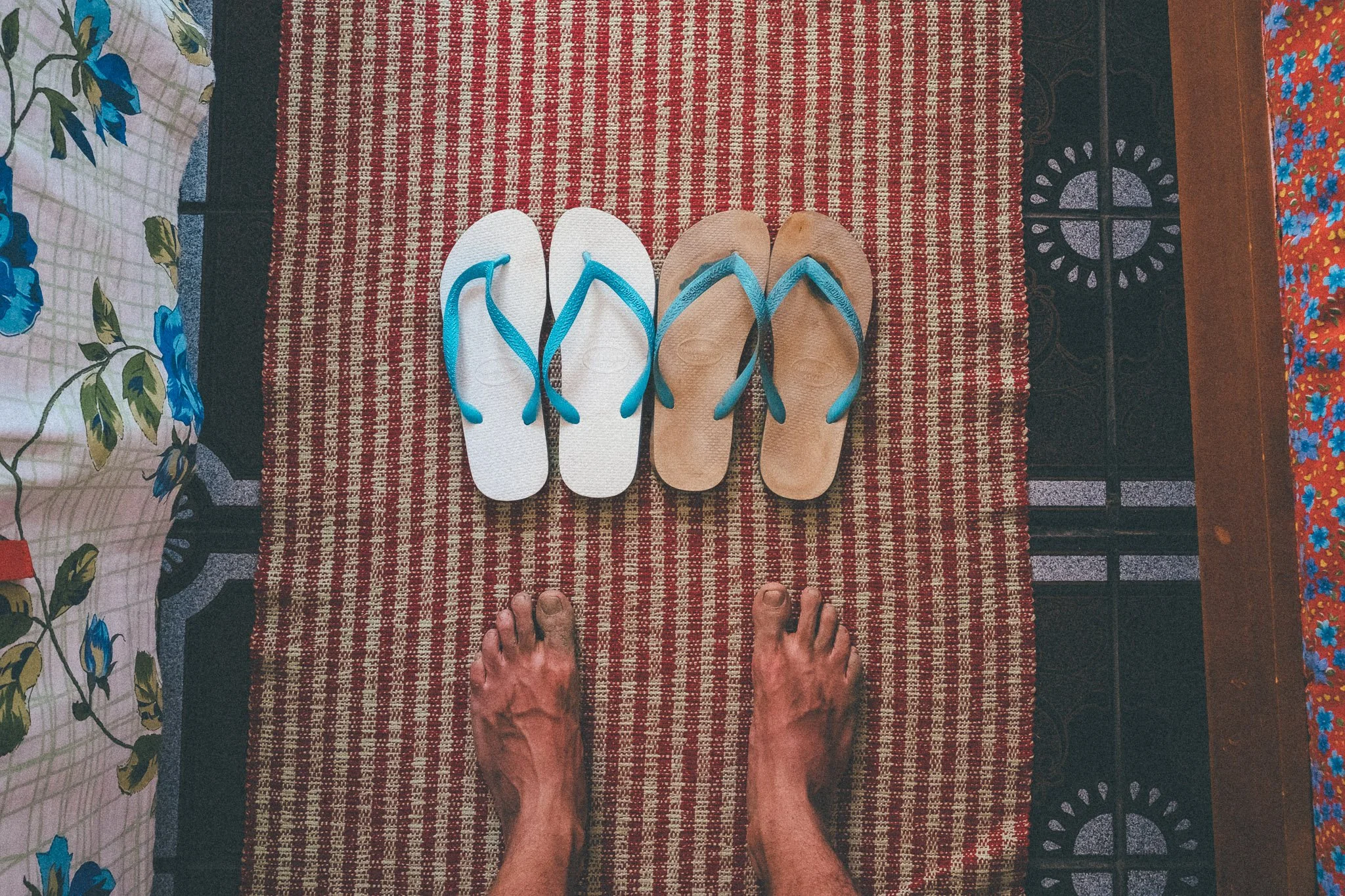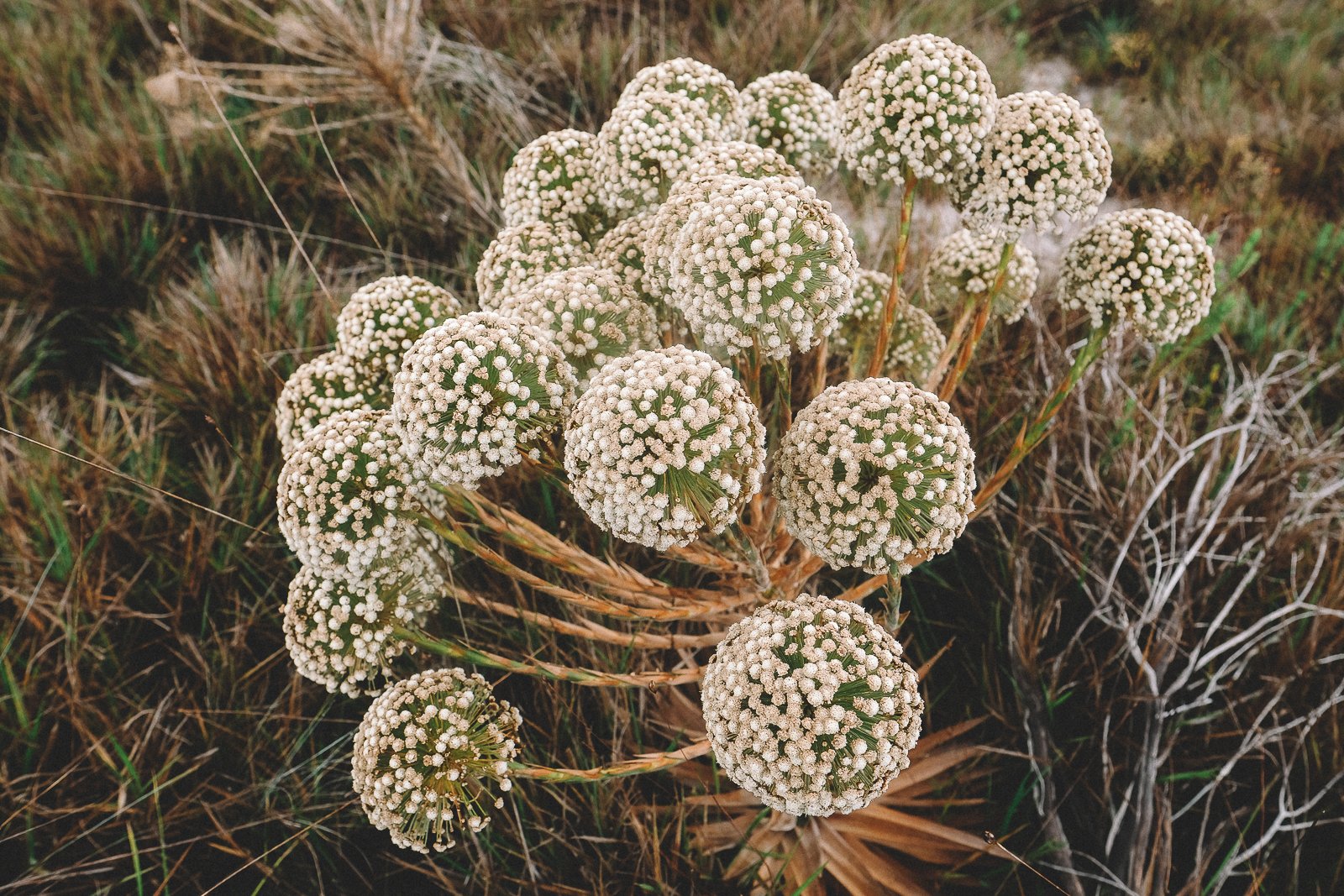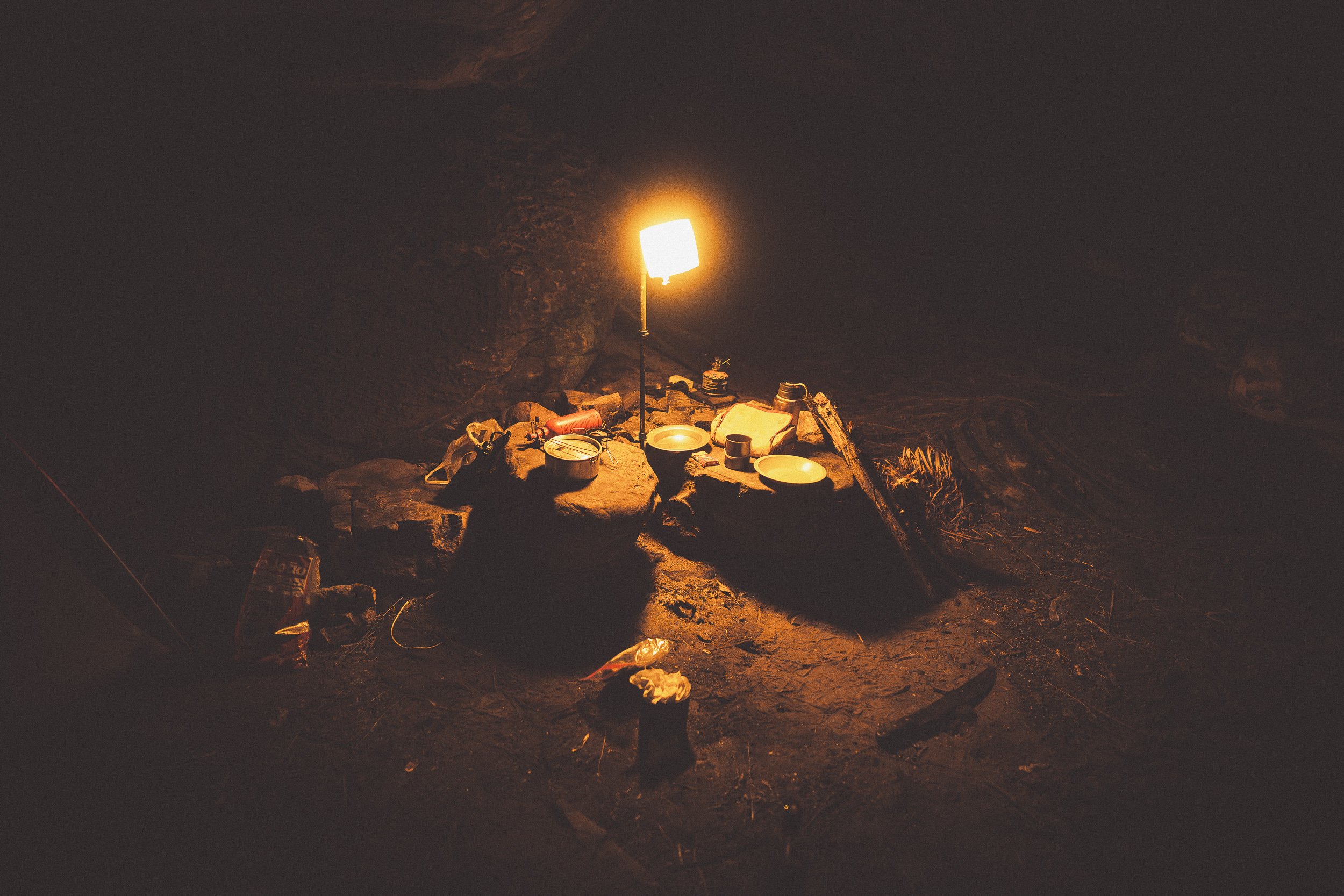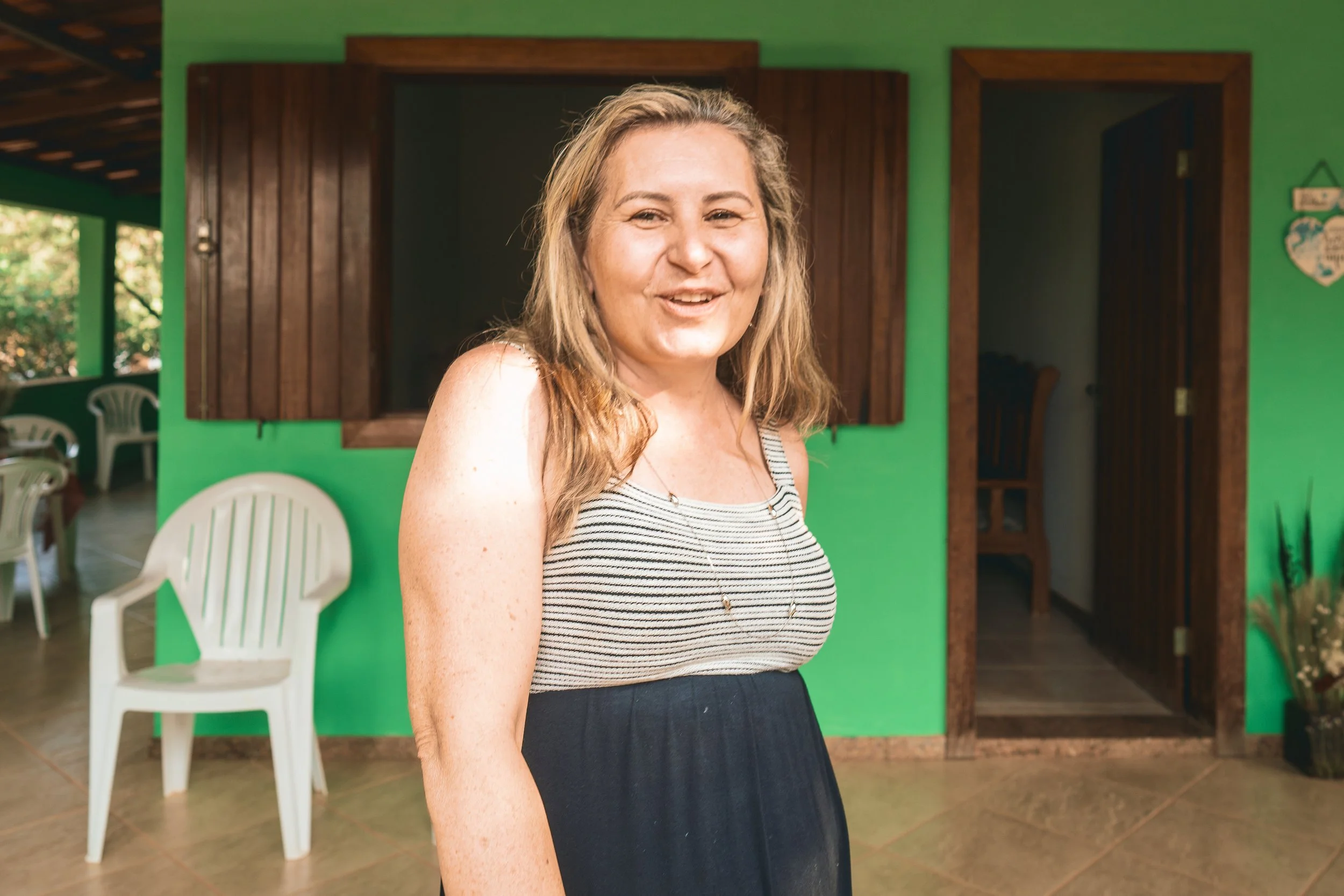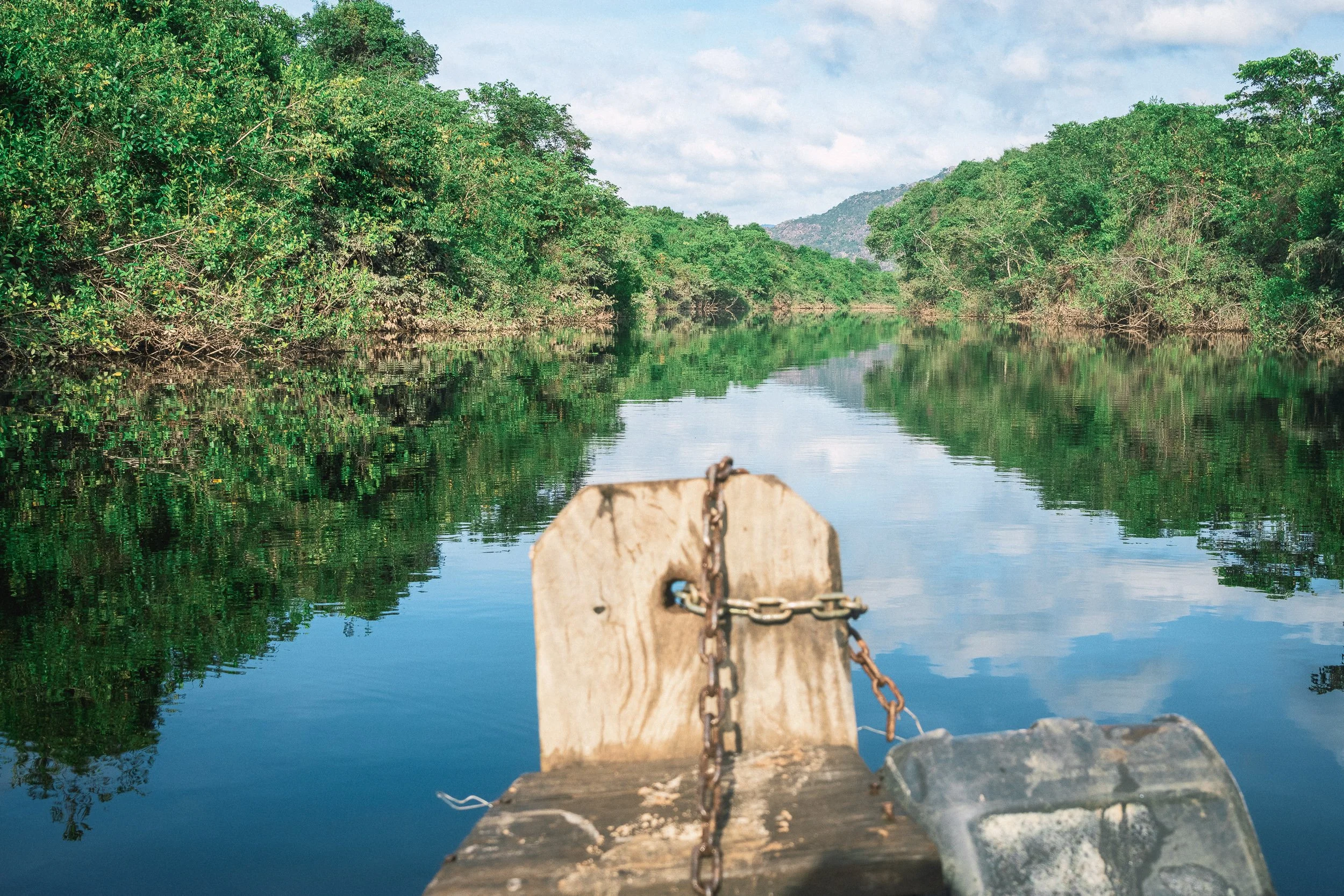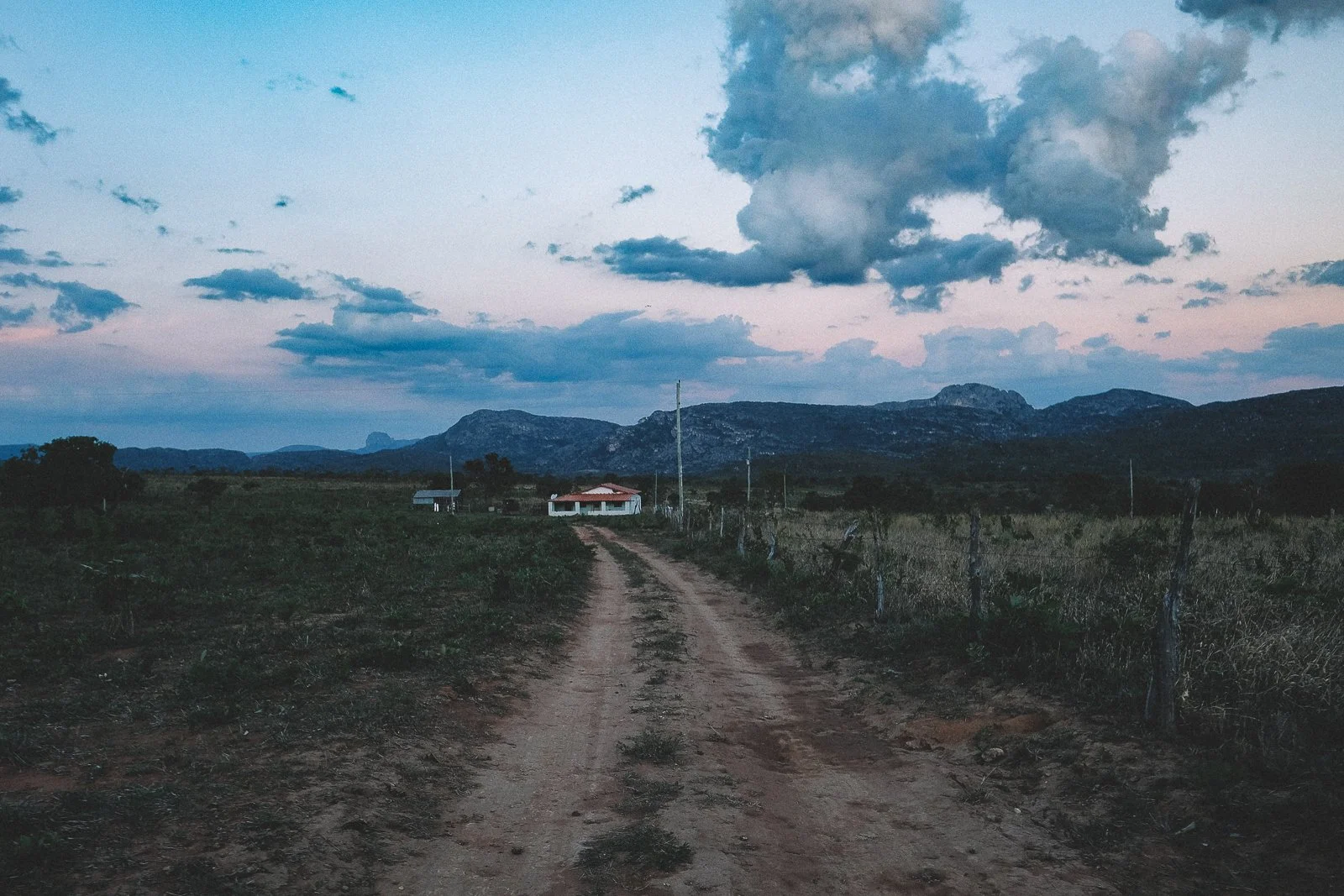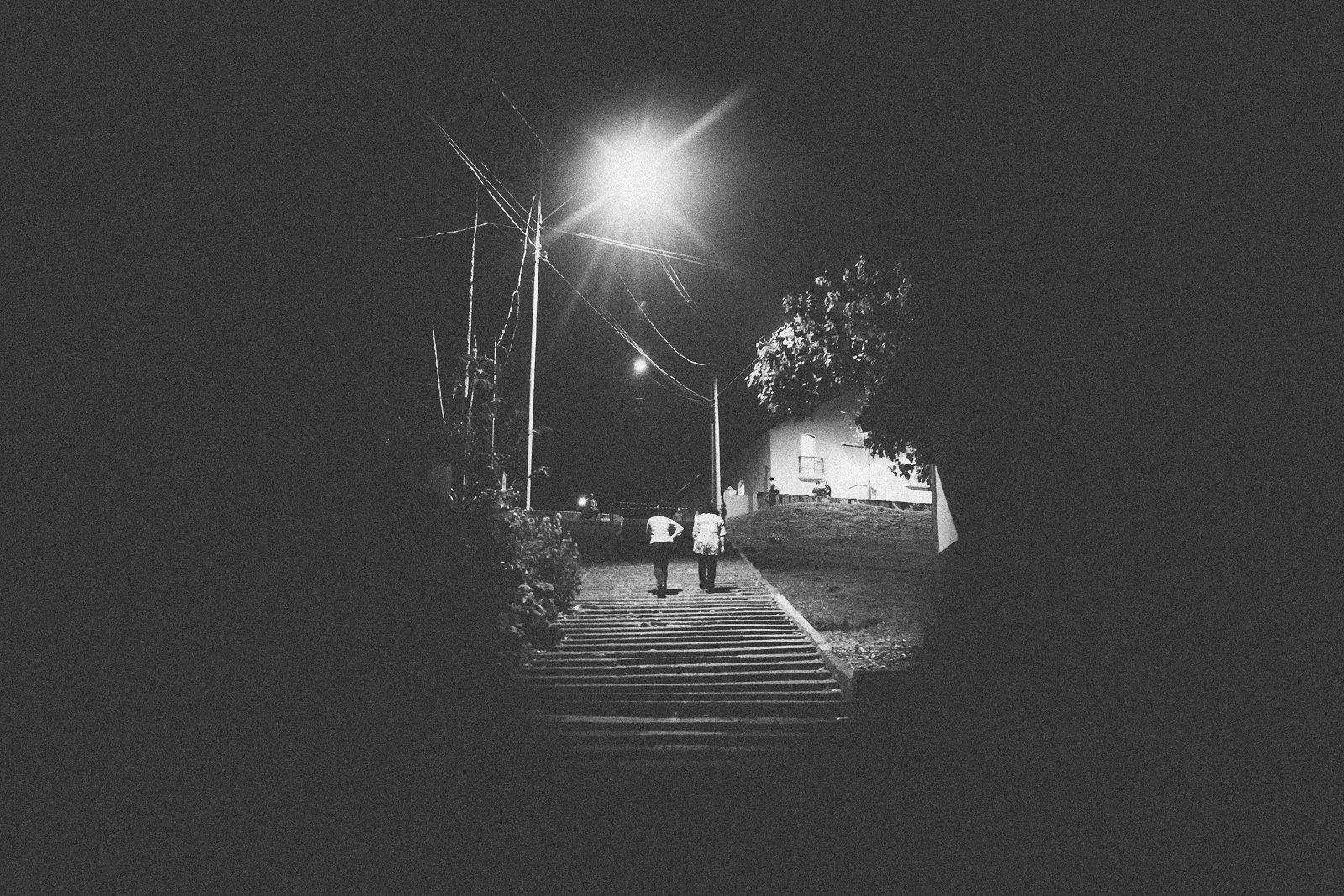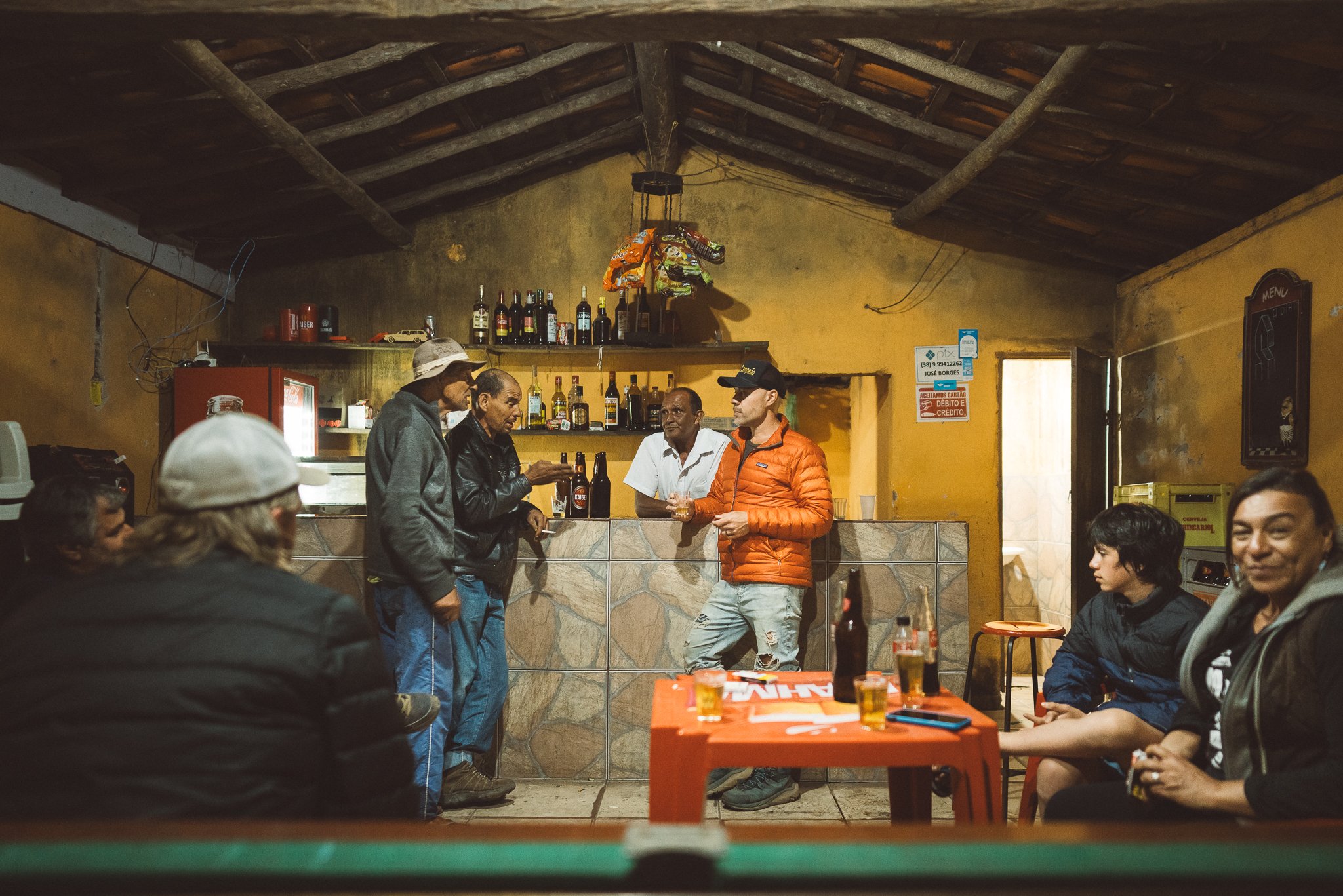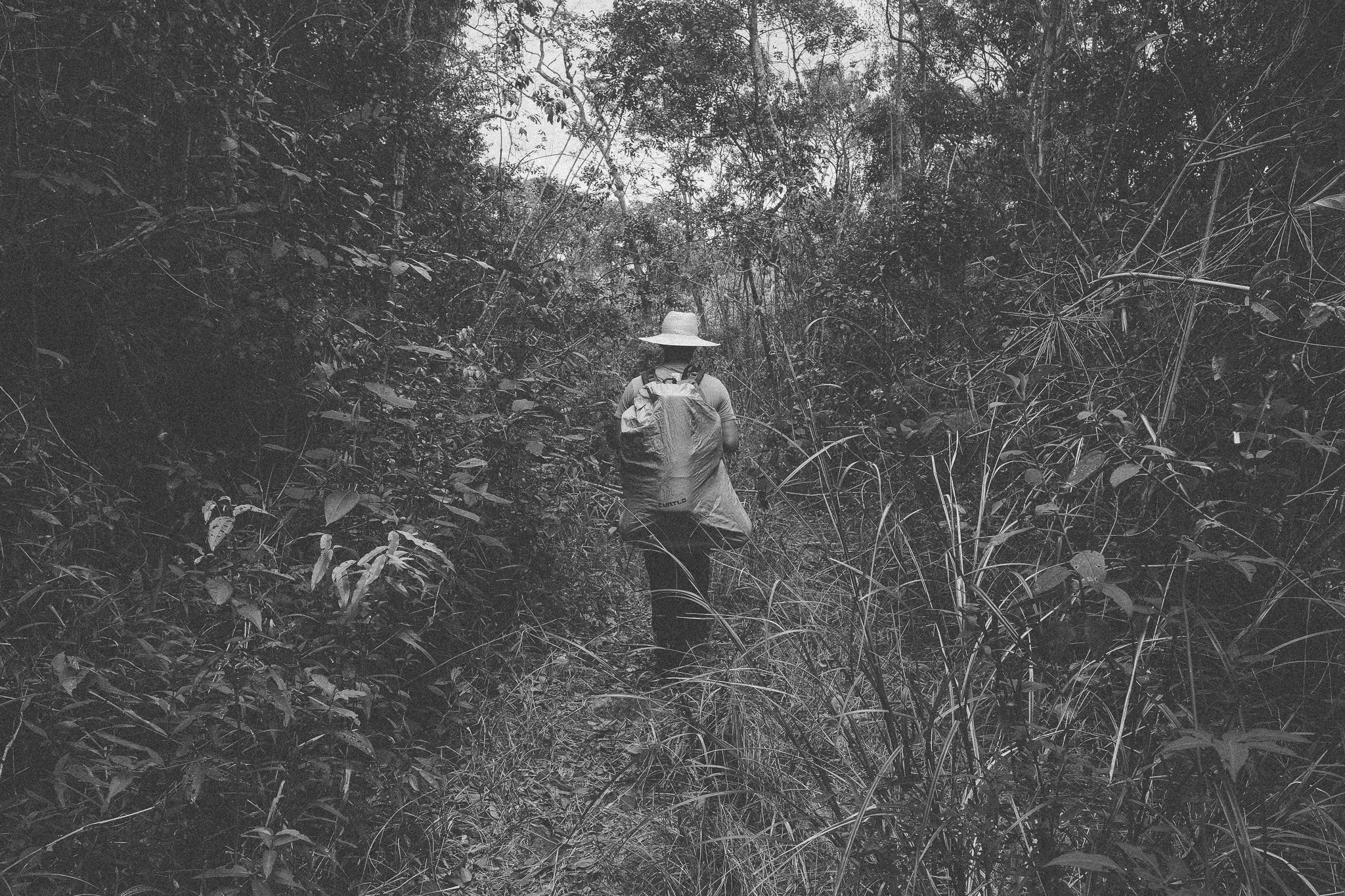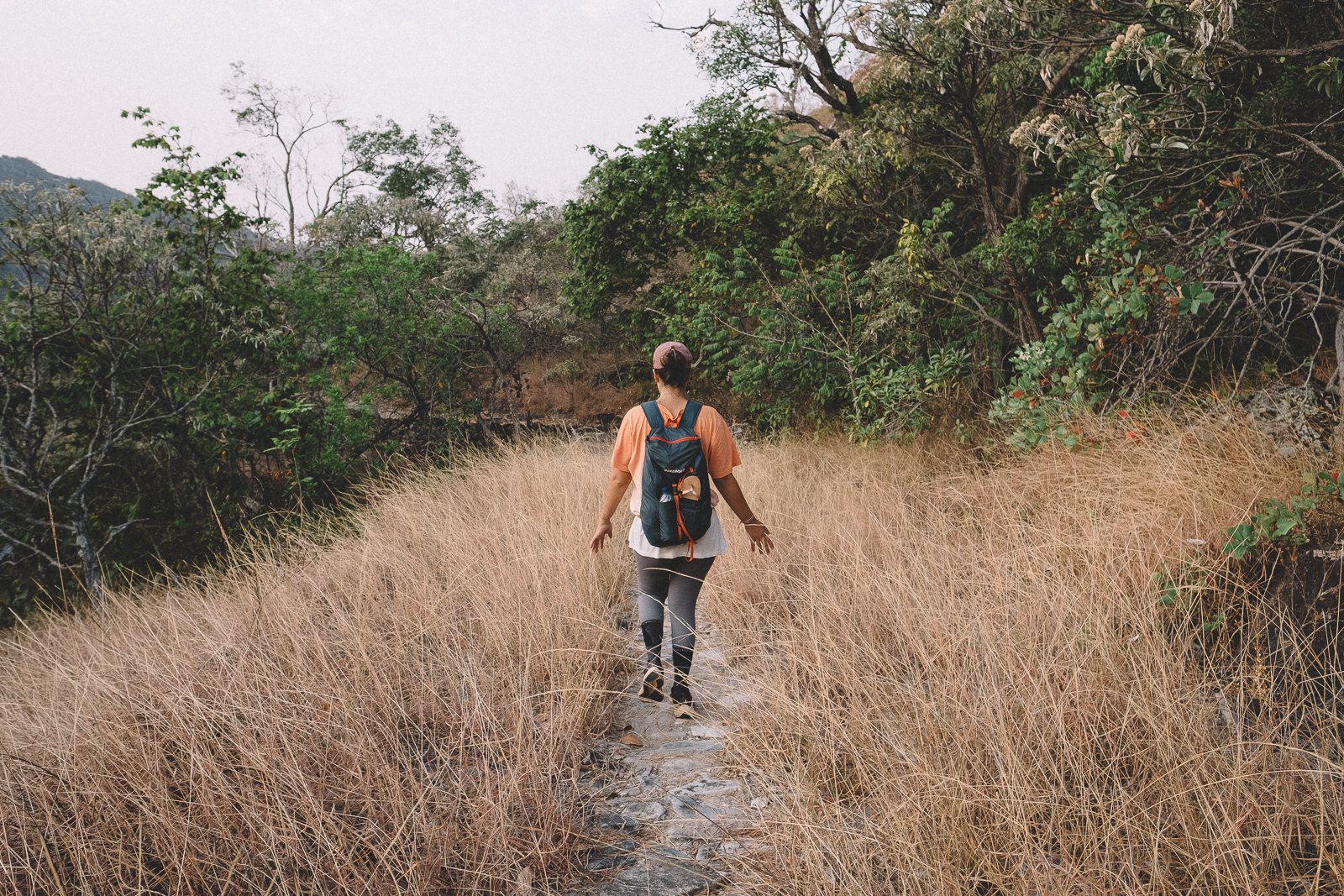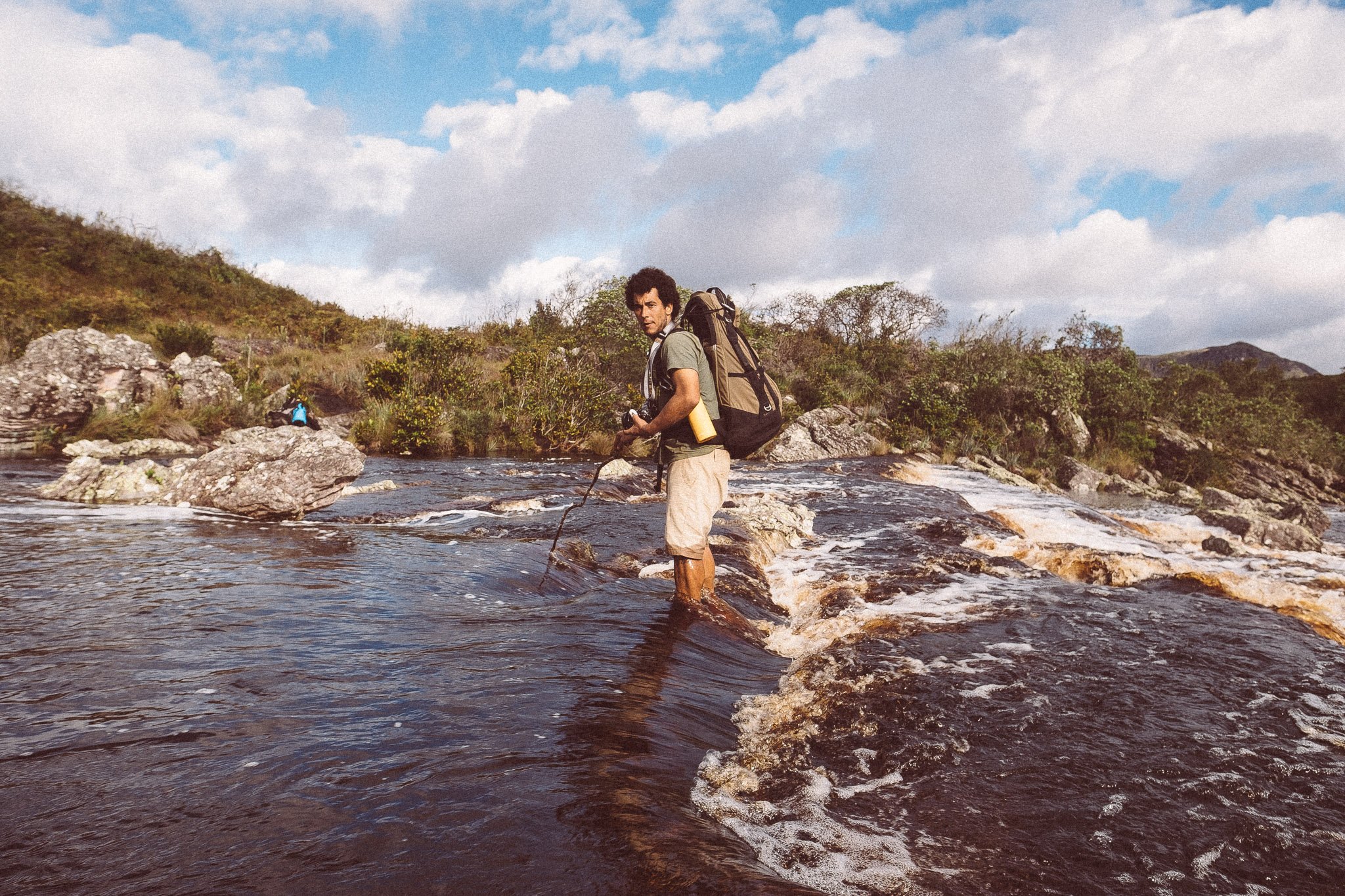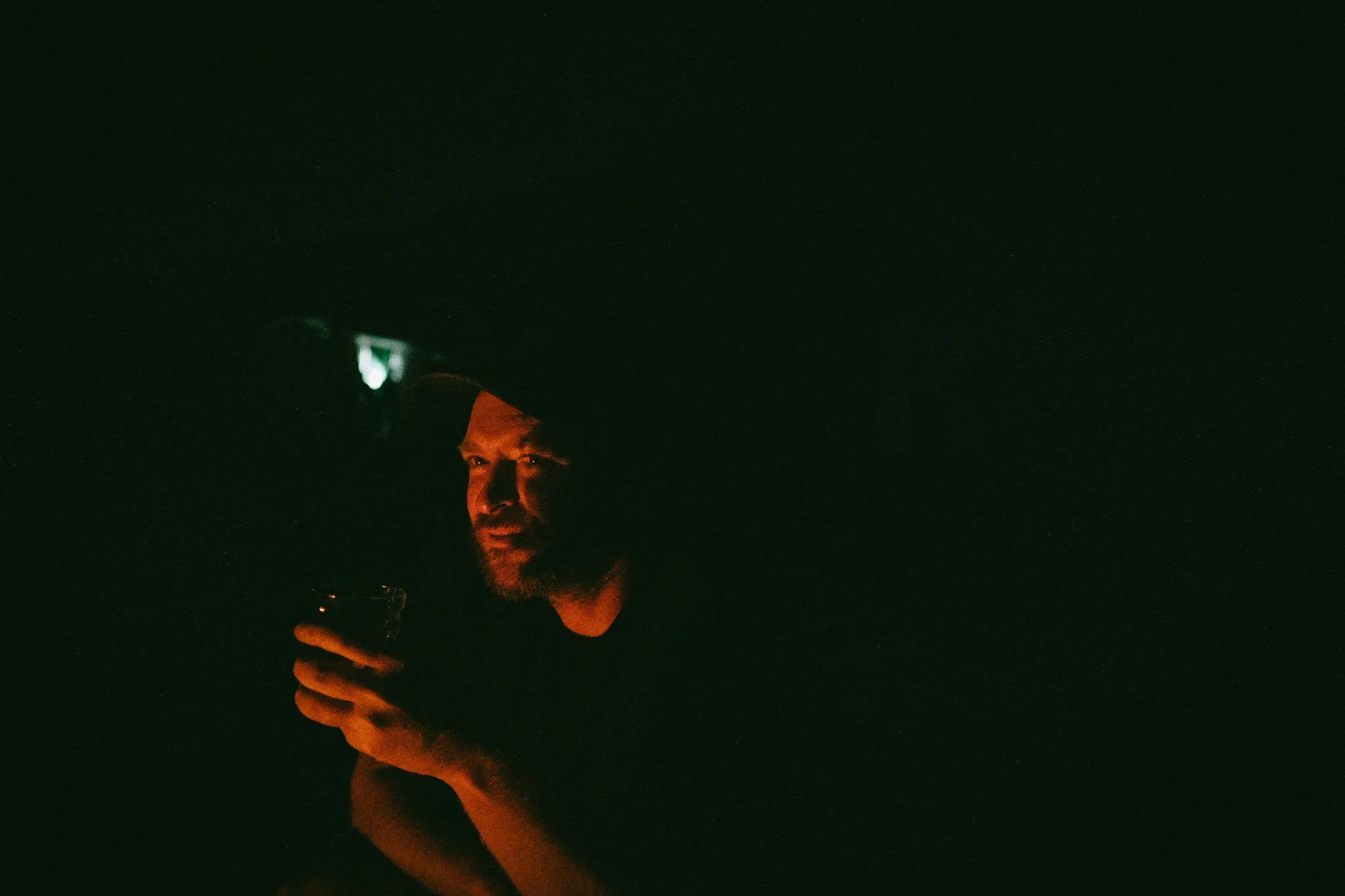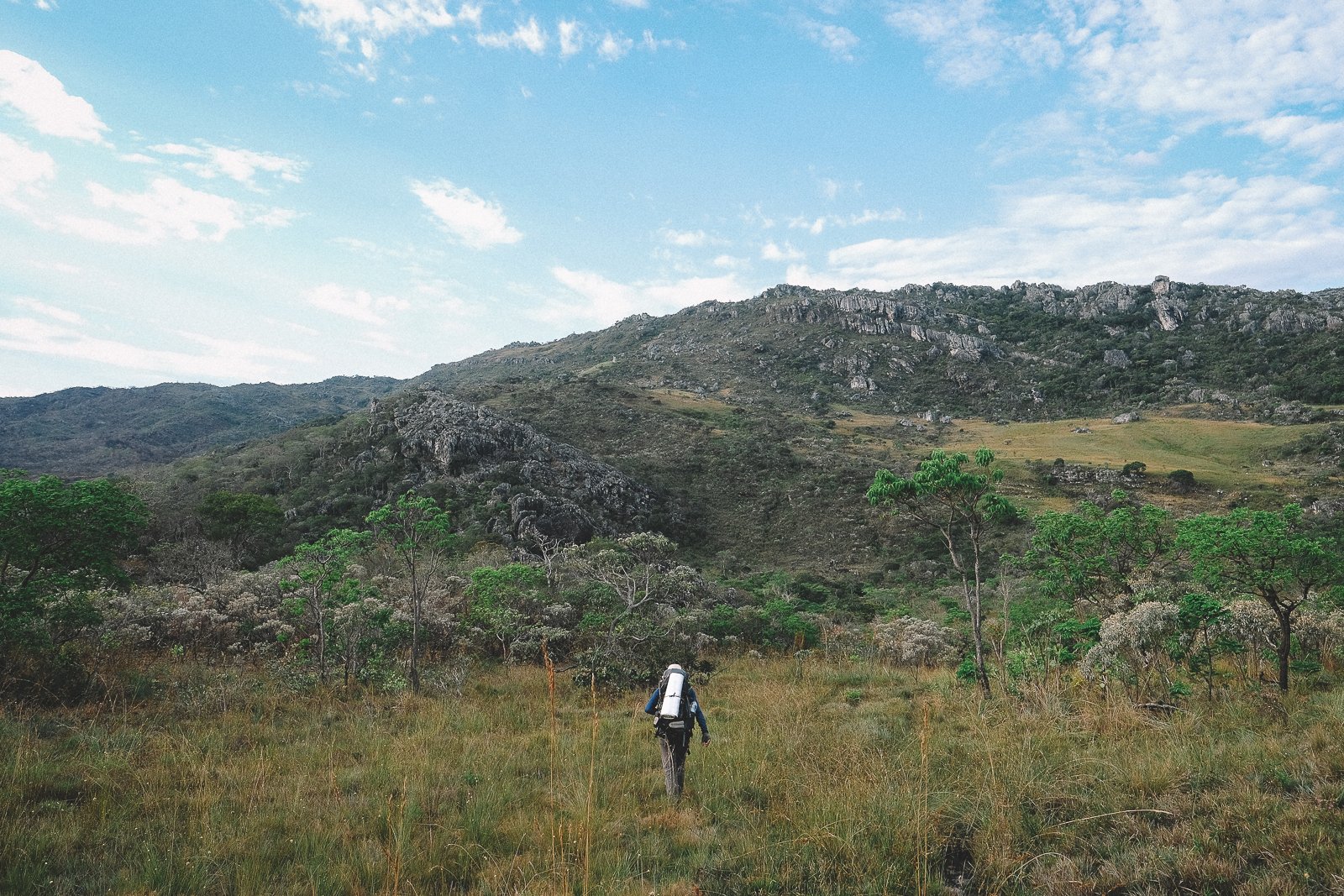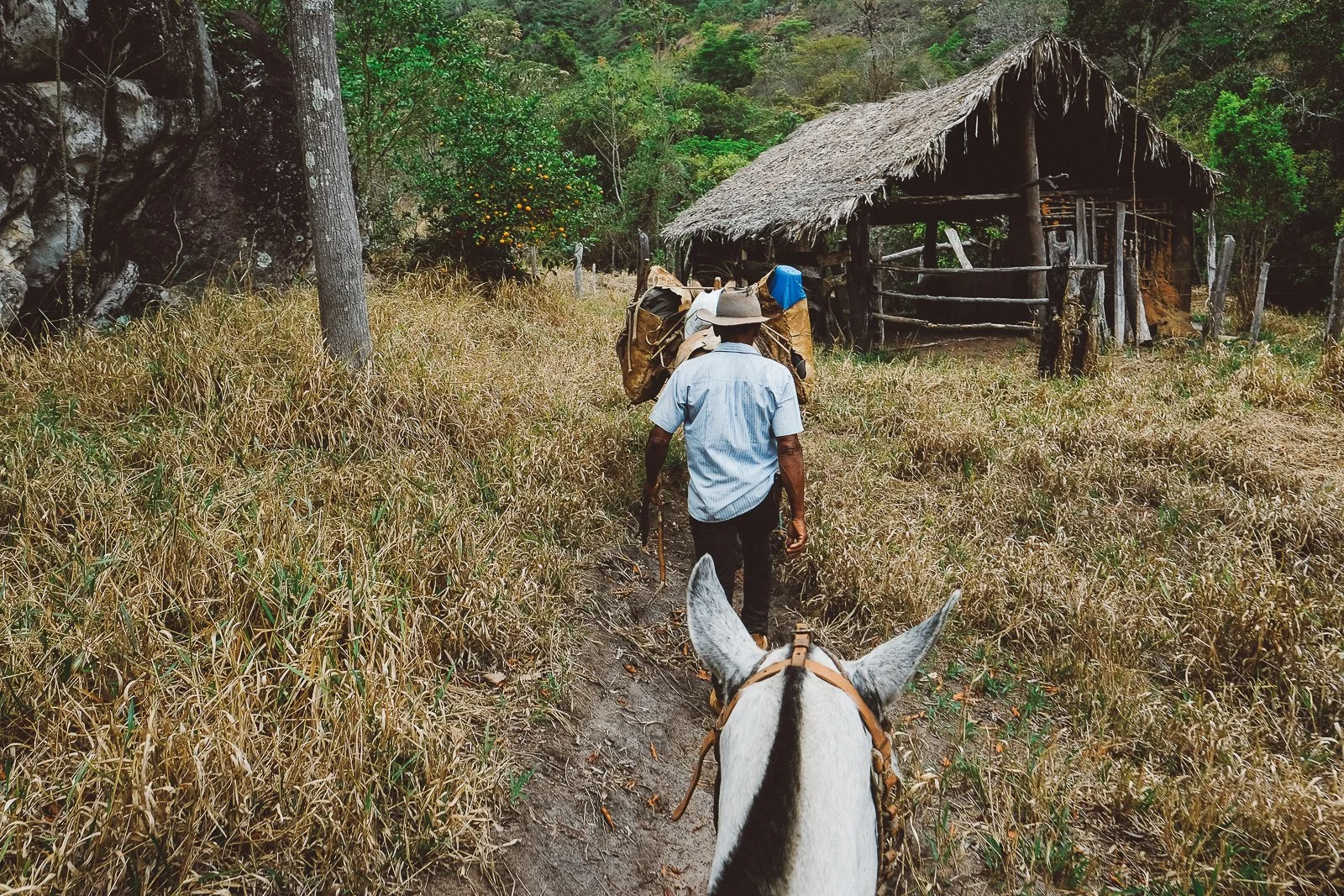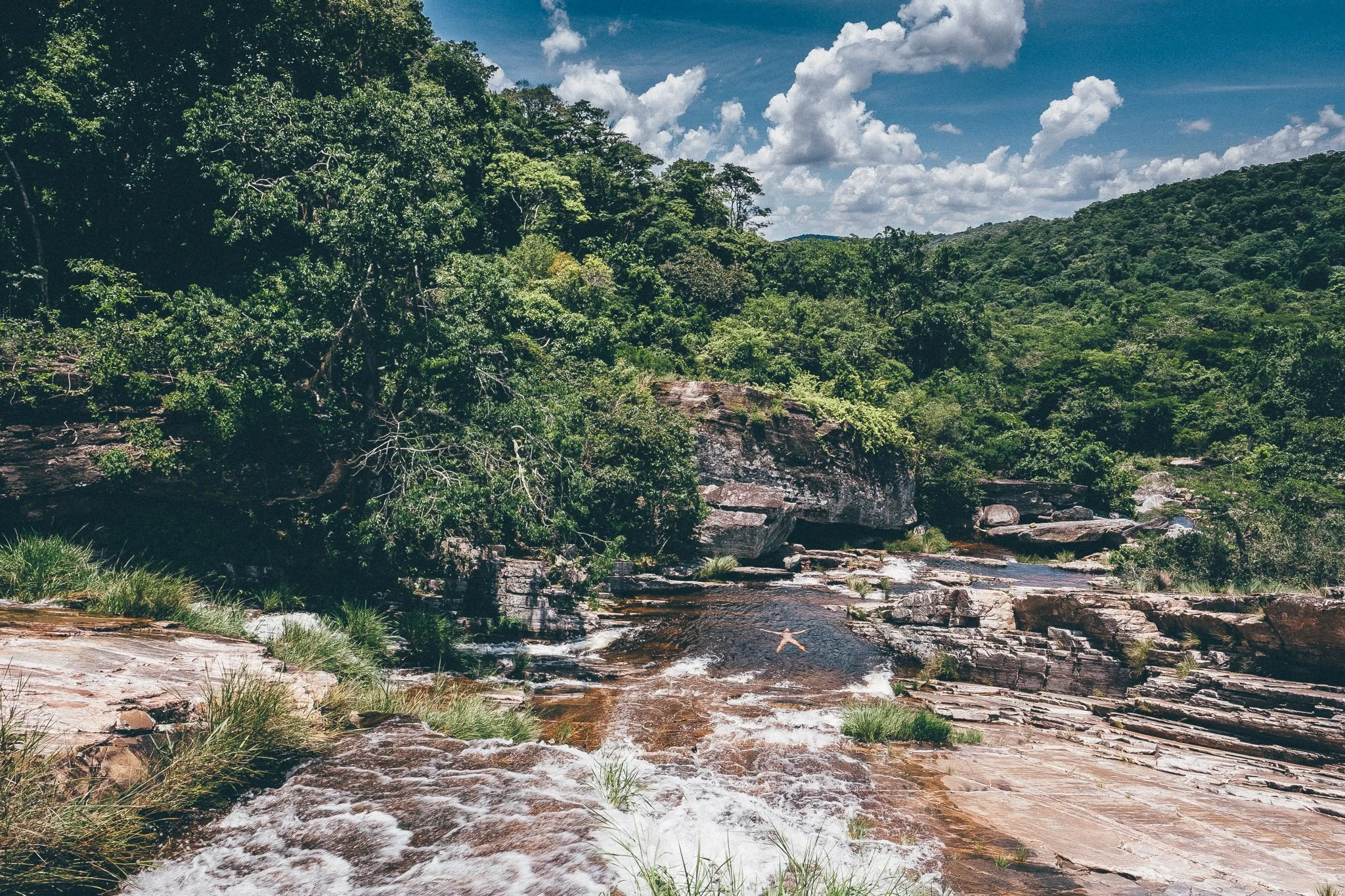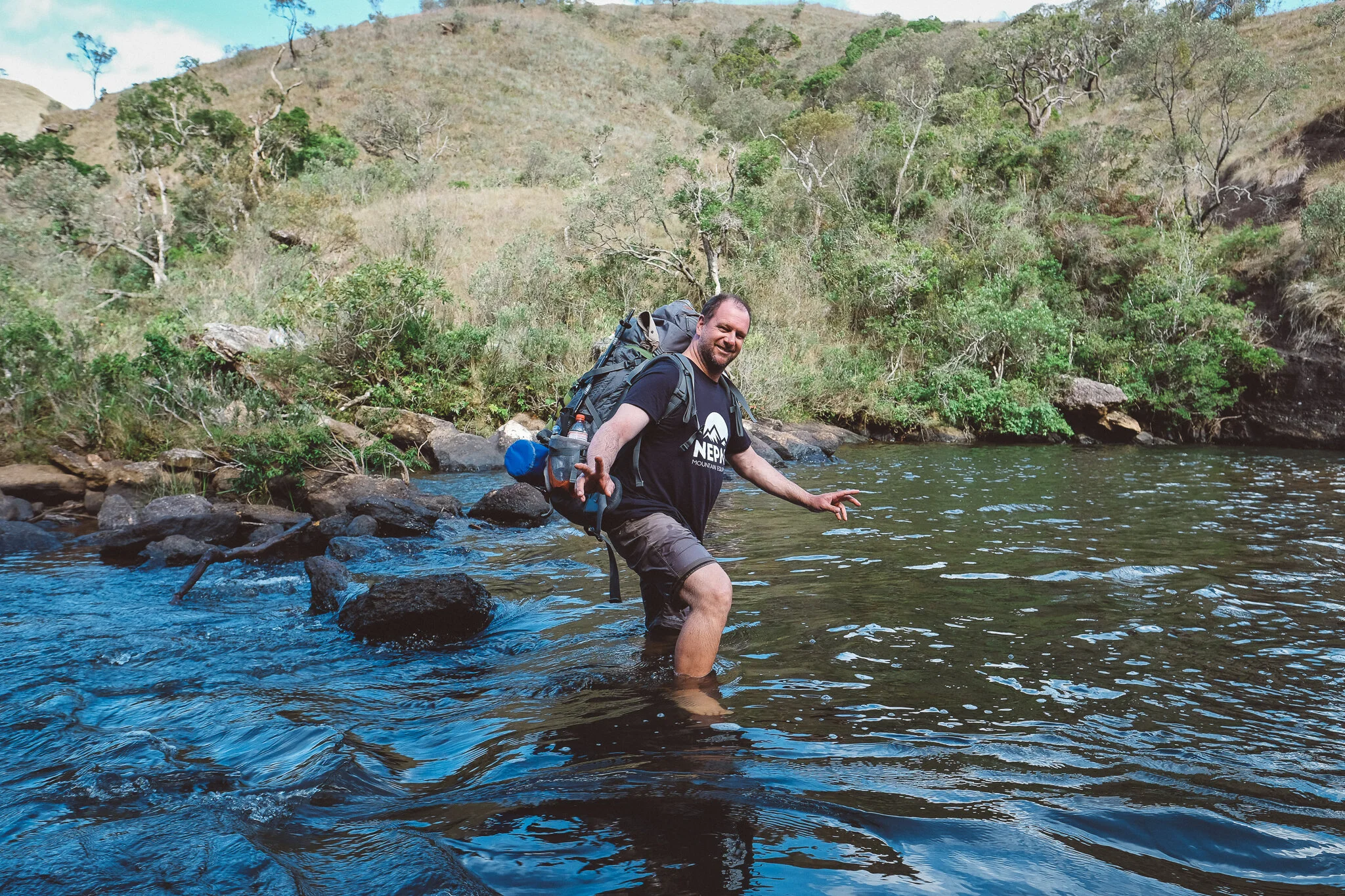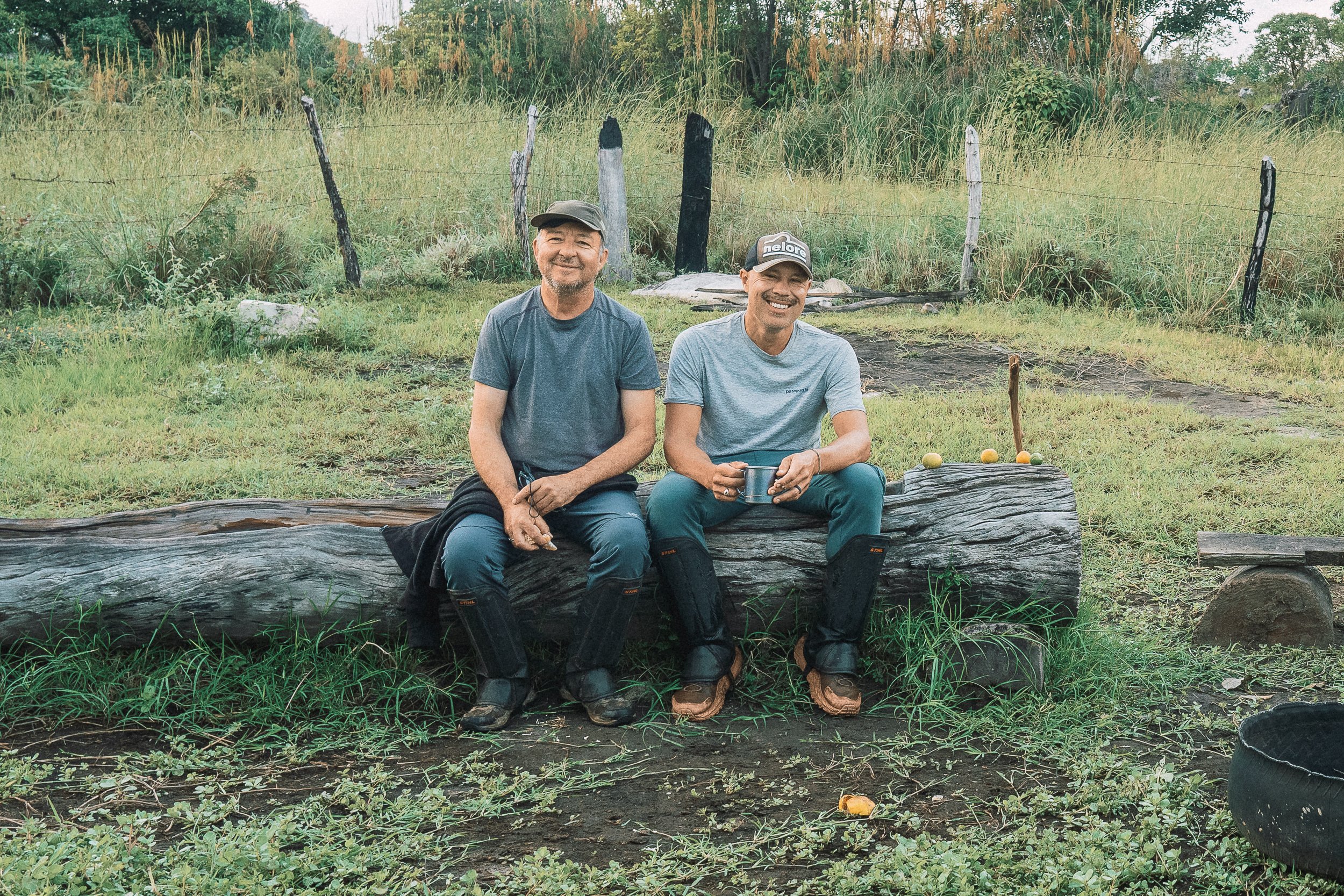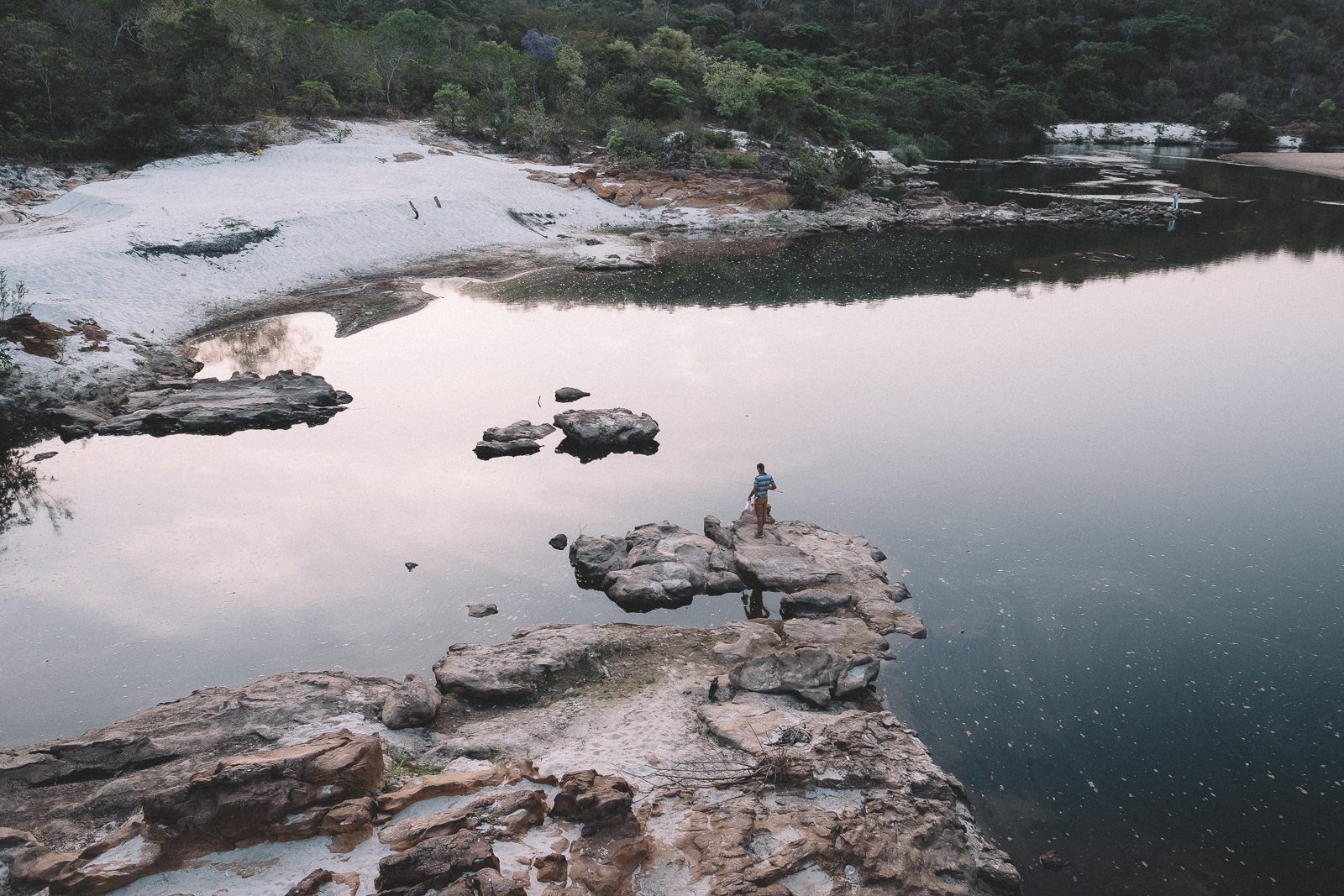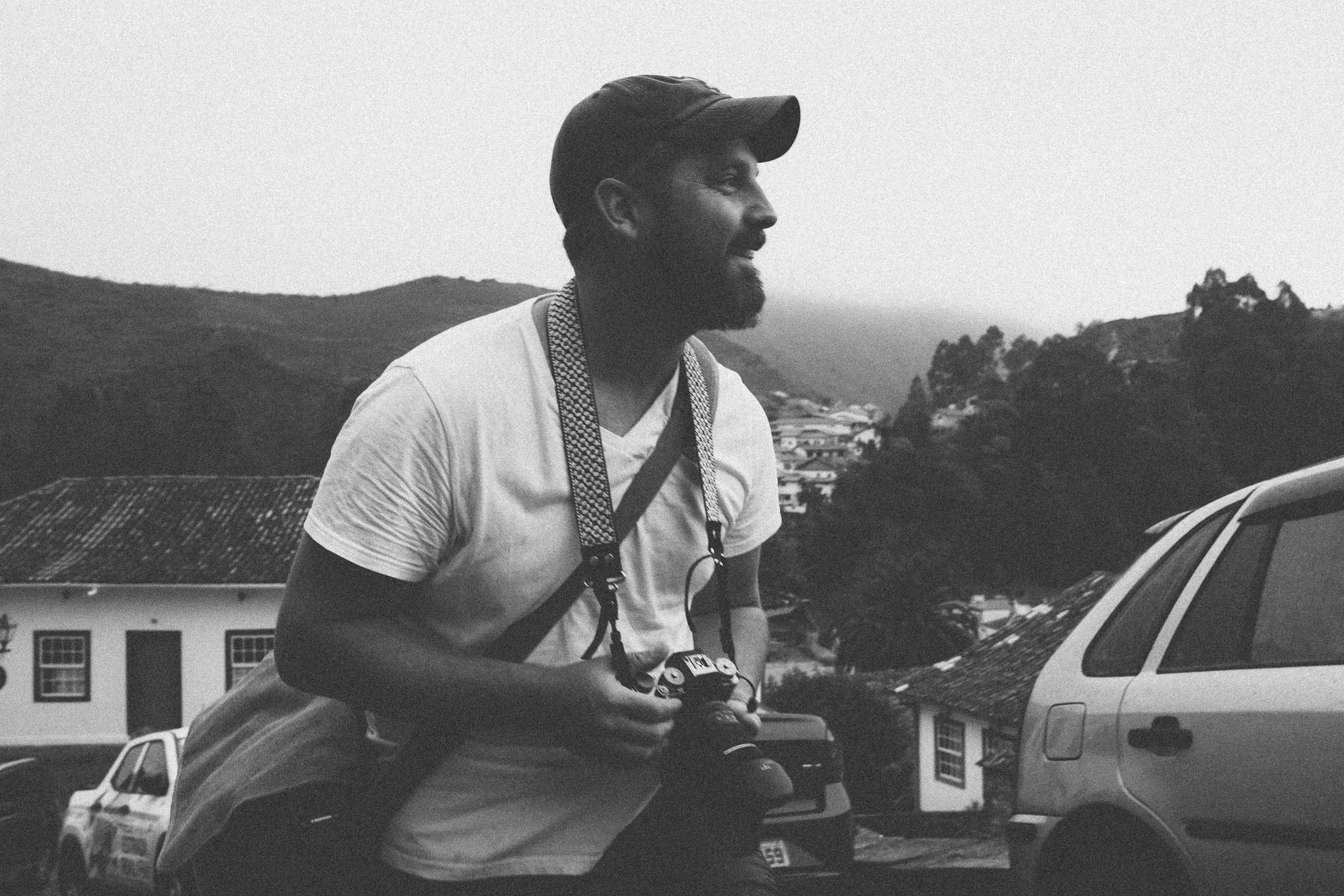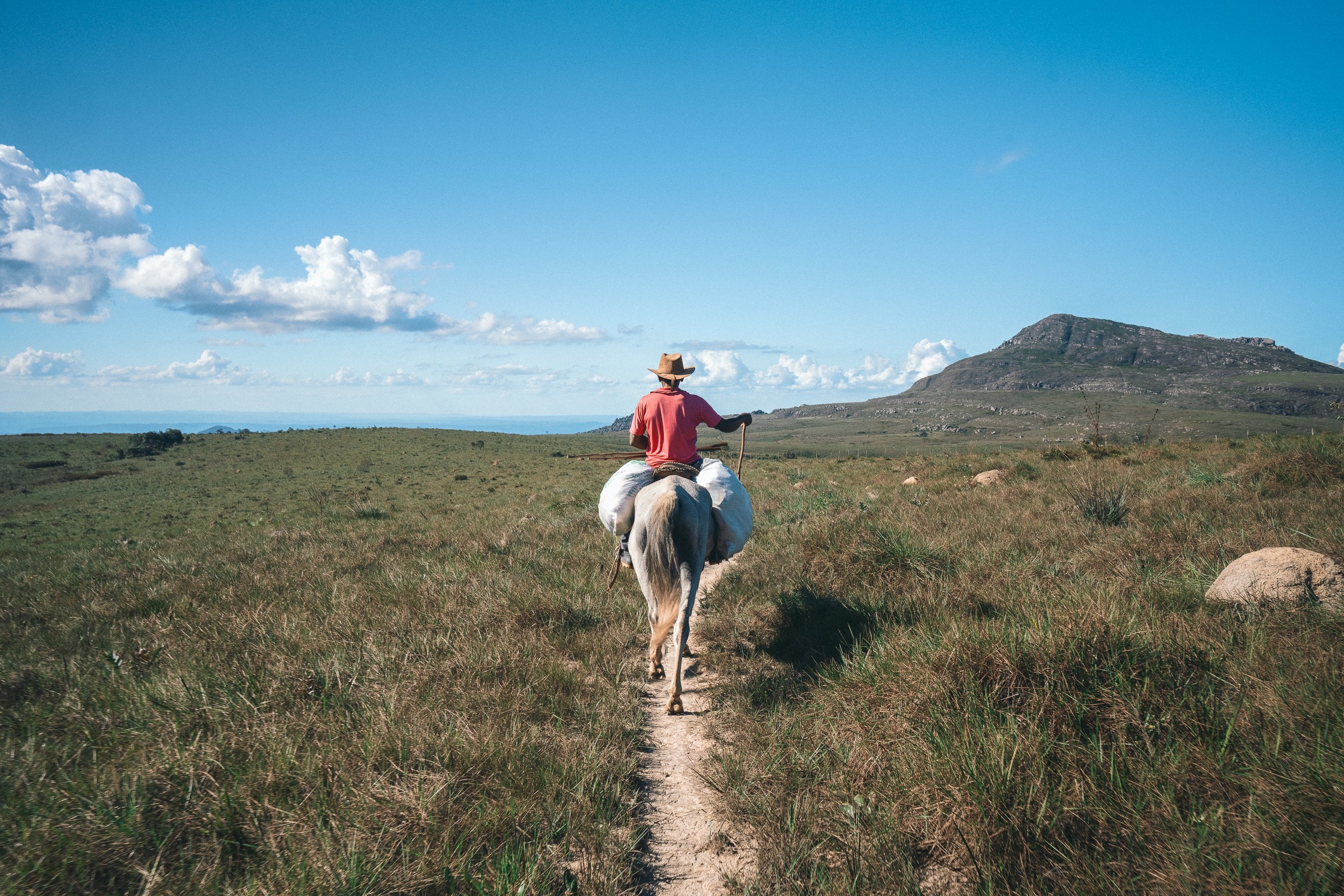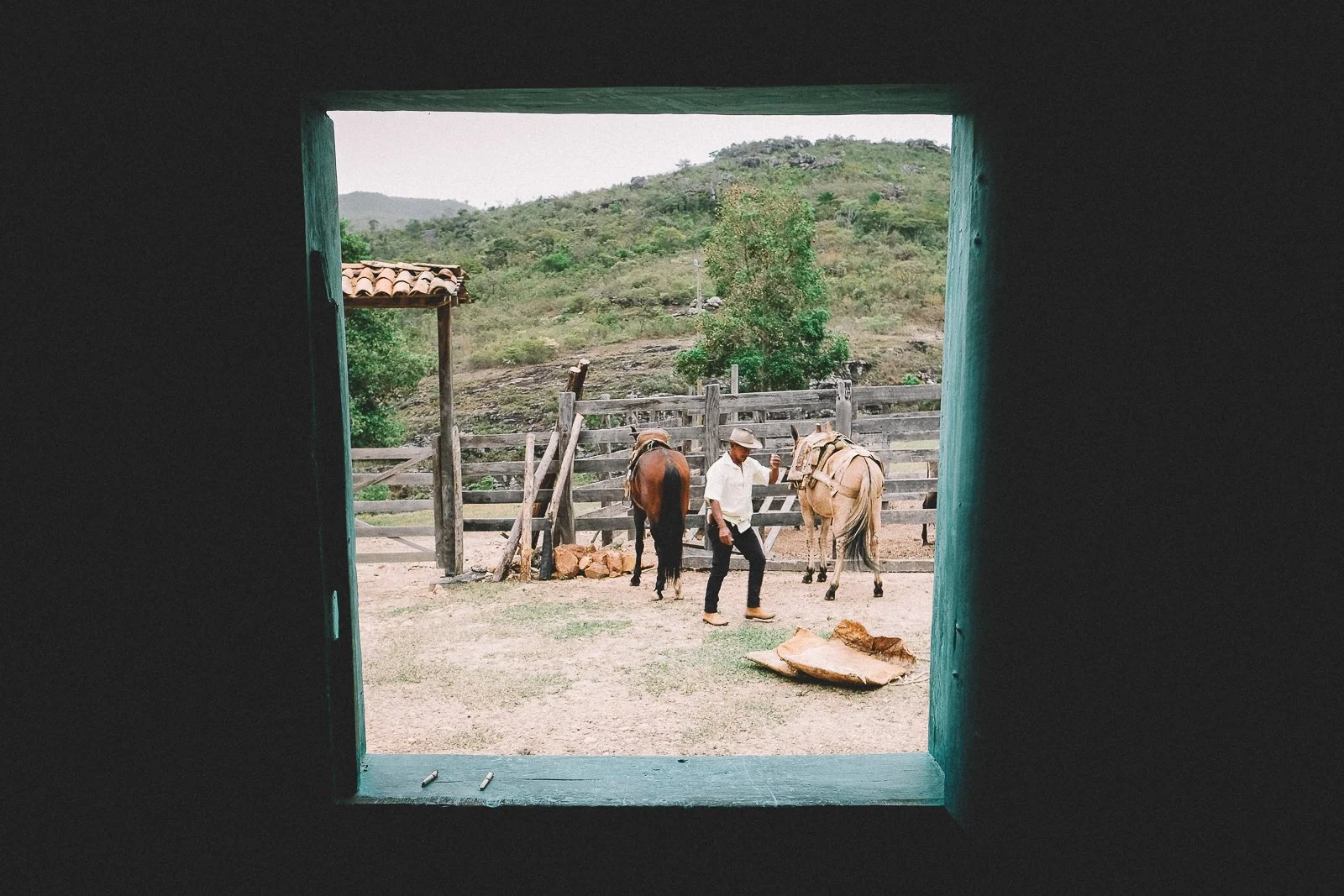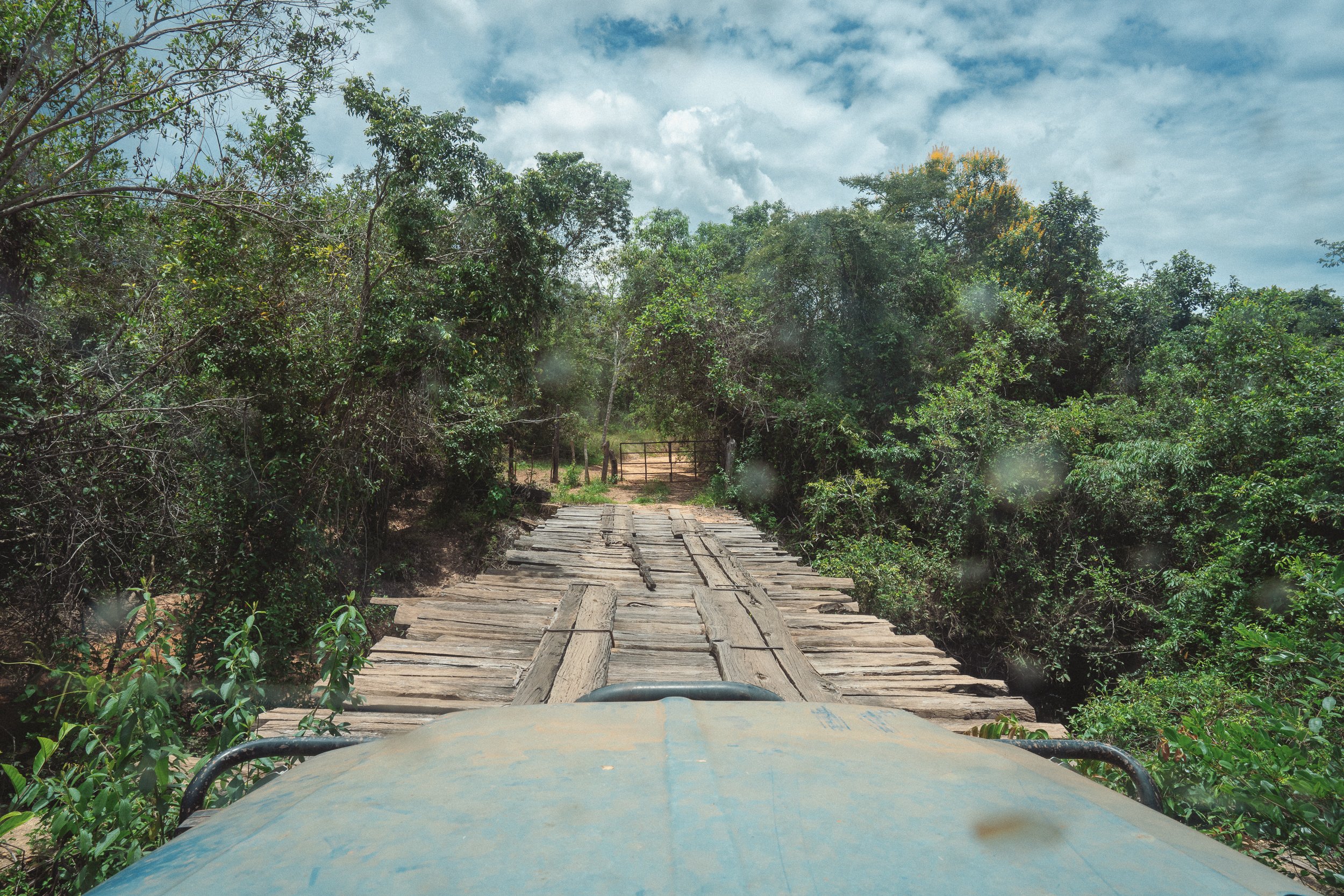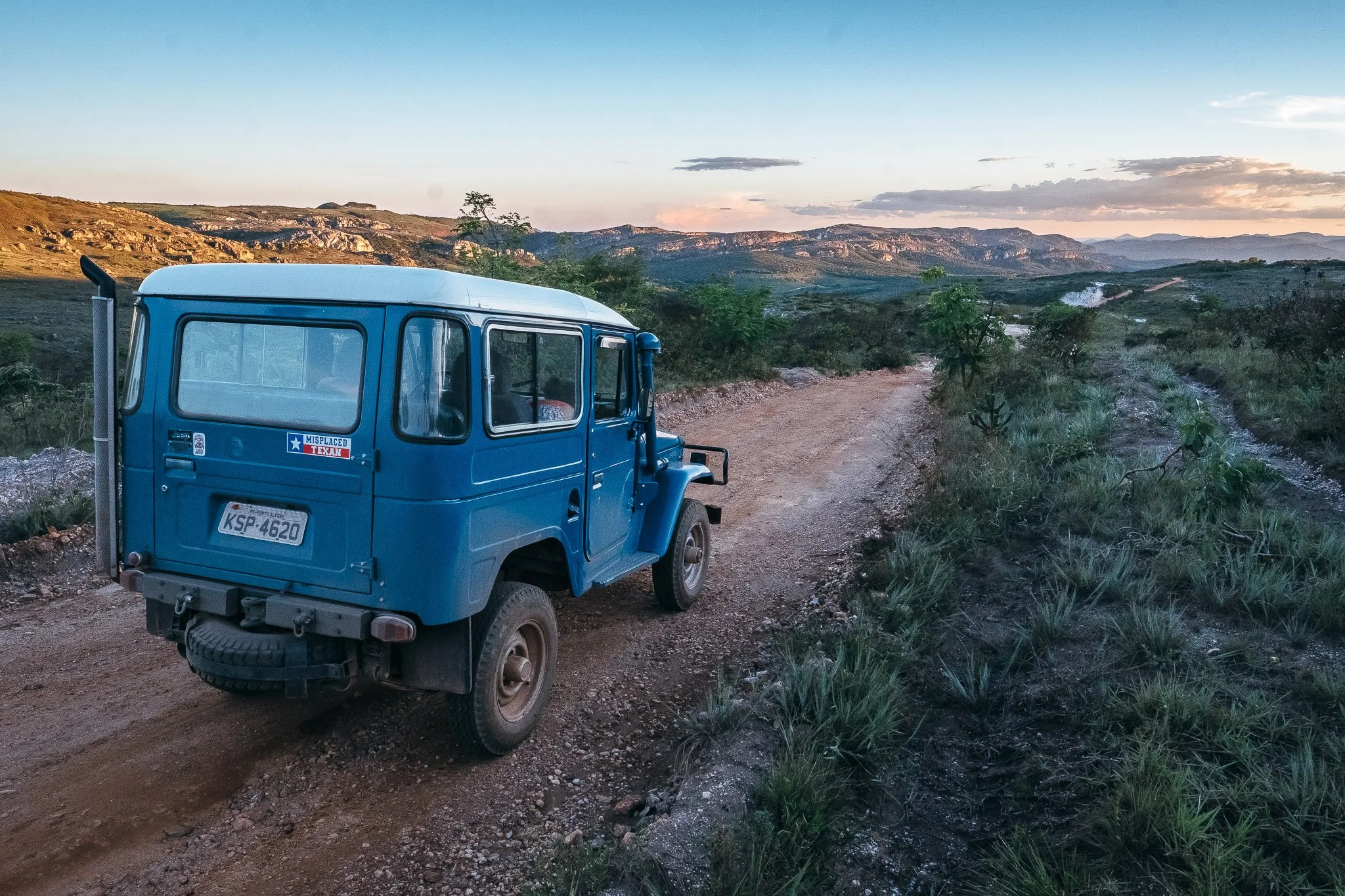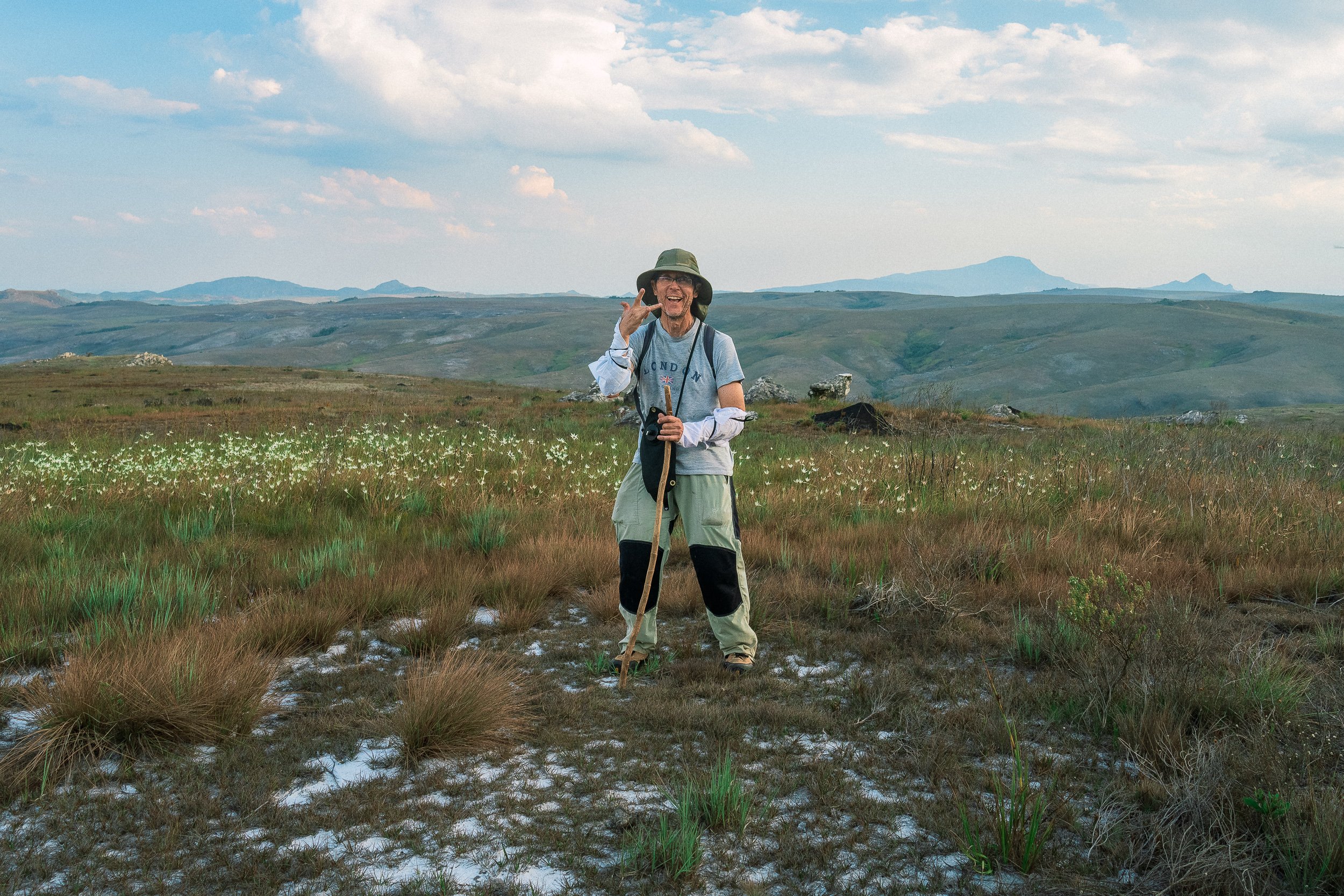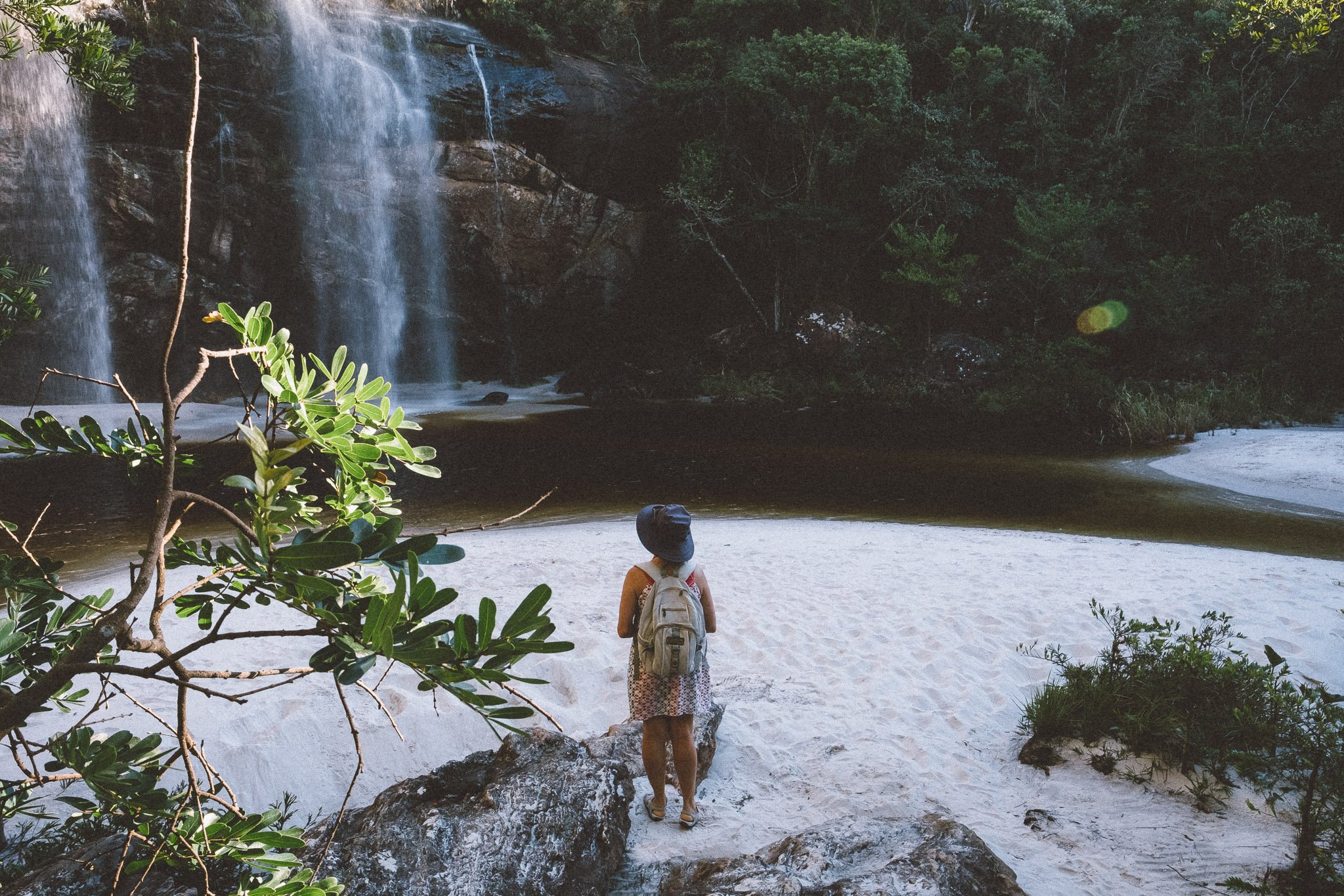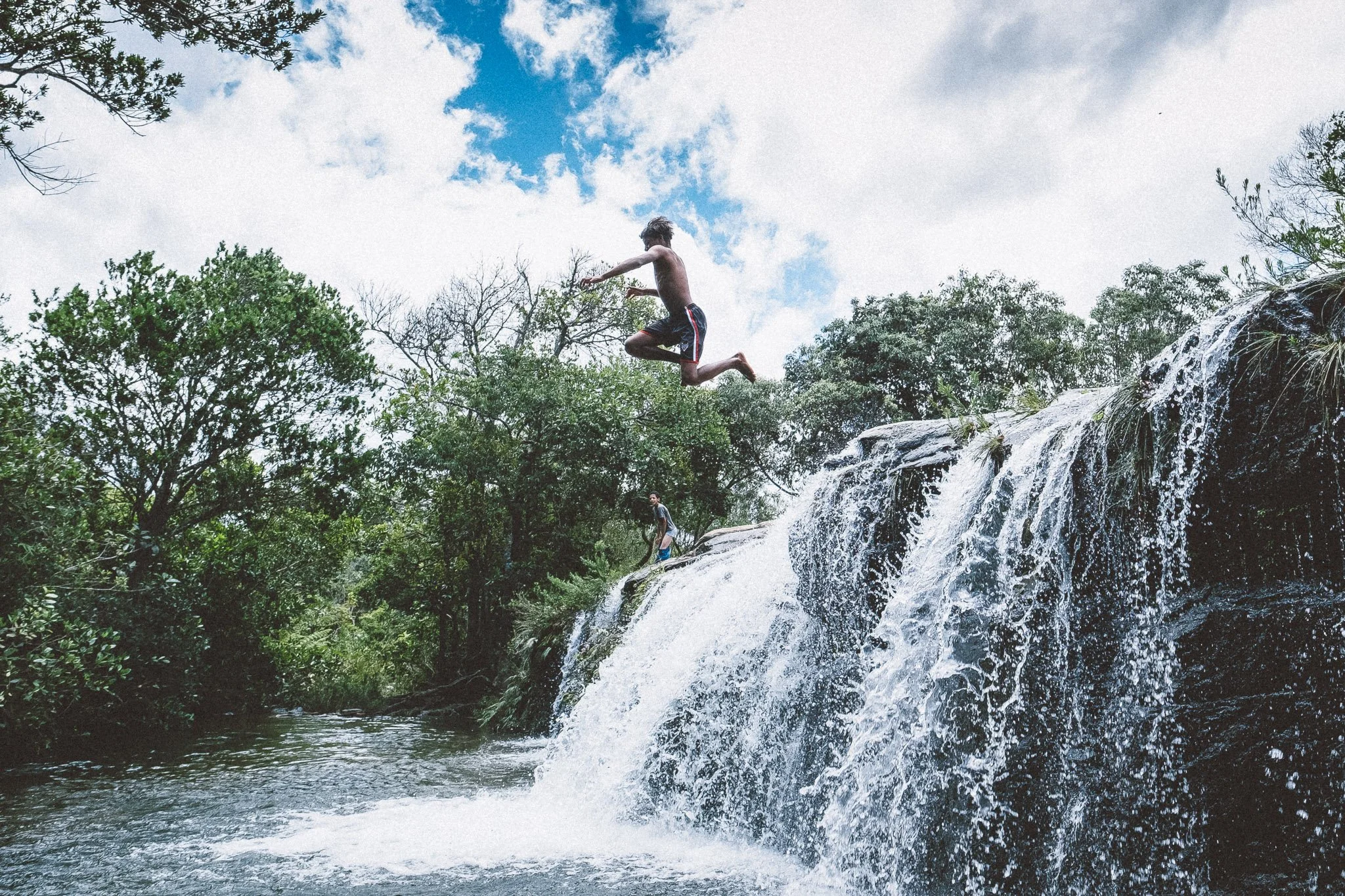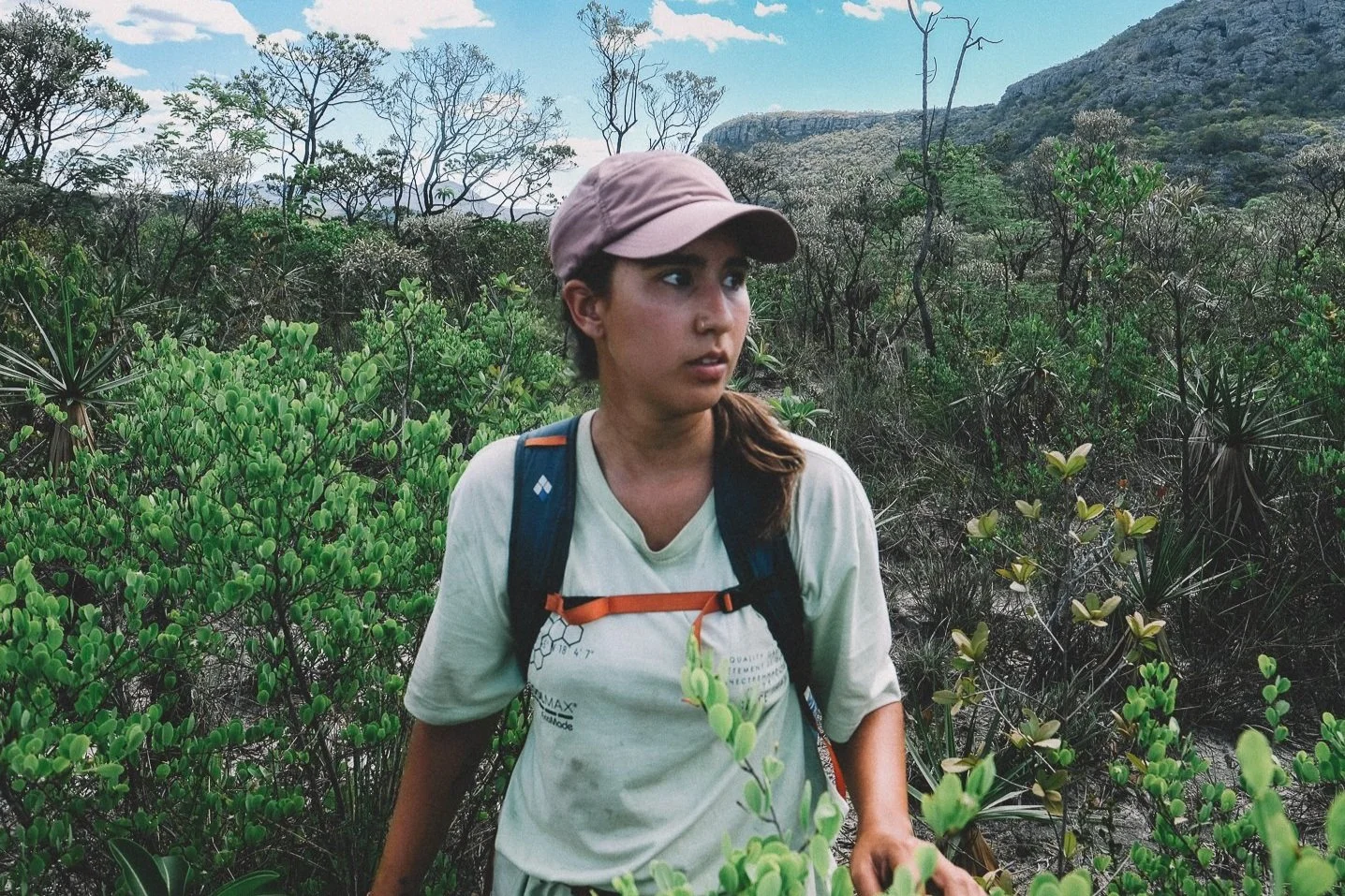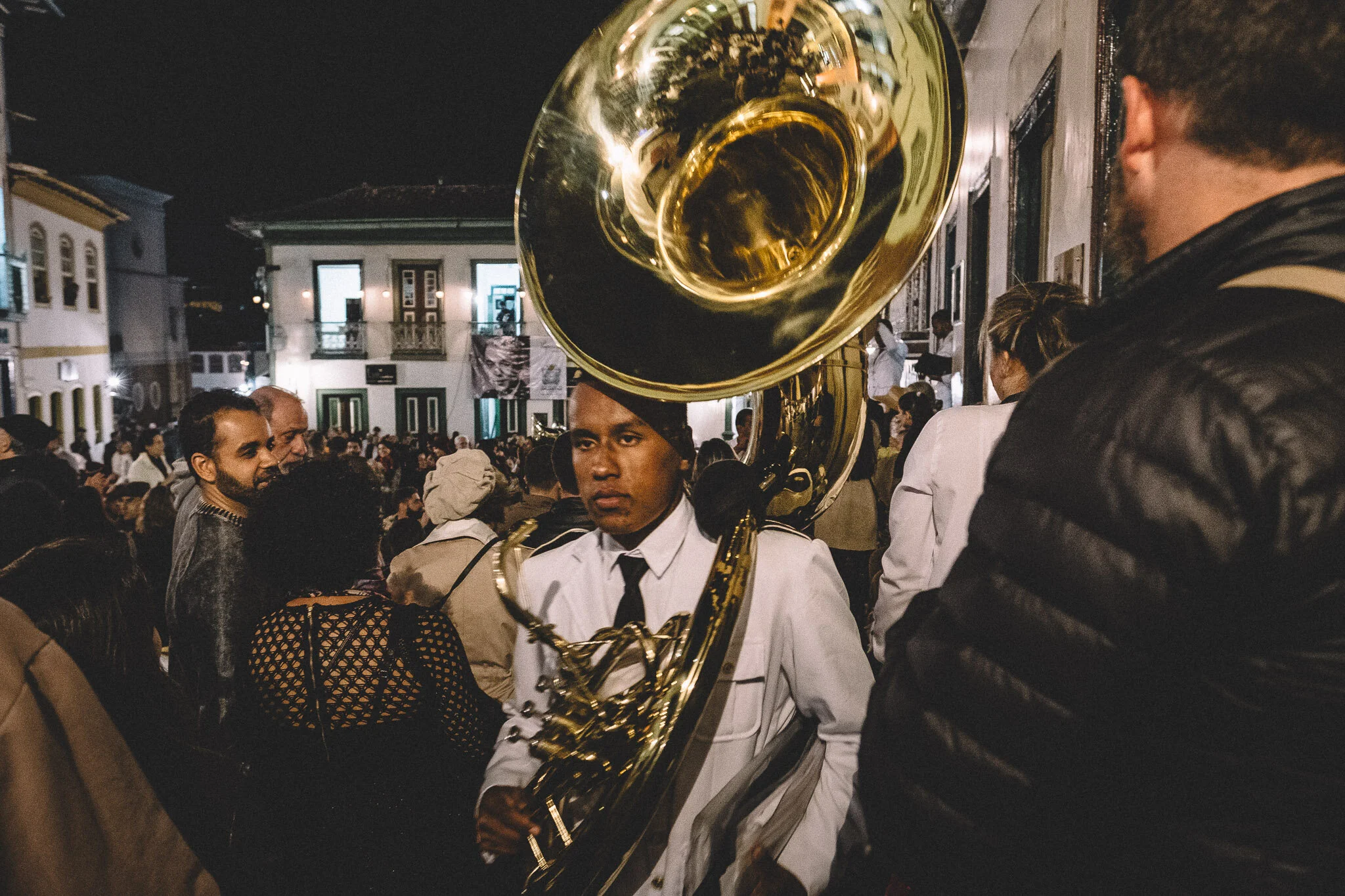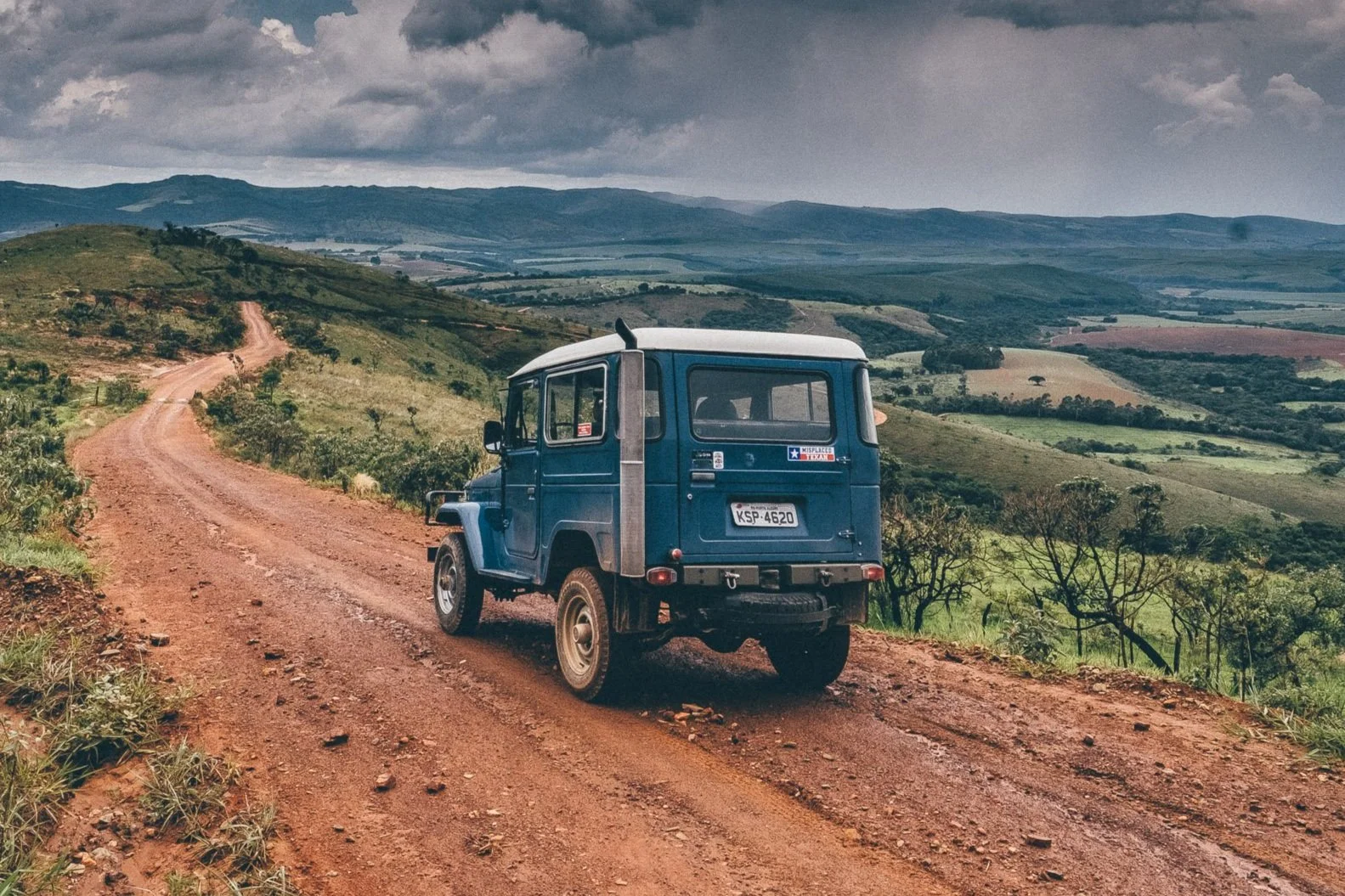
“A profound and magical experience that will leave a mark on your life…
I cannot imagine someone returning home with the horizons they had before.”
- Márcio Bortolusso,
Brazilian Explorer & Journalist
Unscripted and unreplicable.
Just you, a dedicated crew, a forgotten range, and the untold Story of Brazil.
We craft and guide these trips for solo travelers who want to go all in, with two founders in the field and a full crew that calls this range home, focused on one life at a time.
Journeys are rare by design.
They’re not for everyone, but for the right traveler there’s nothing like them.
-
You’re here to experience life as few have, in a part of the world few travelers know. We’re here to show you just how vast and enriching that experience can be.
Journeys were the first trips we ever designed in the Espinhaço, and they remain our most personal, concentrated expression of how meaningful travel can be: adventure, perspective, and catharsis through myth, motion, and presence.
These are private expeditions for solo travelers, crafted and guided by our founders to bring you into the Story of Brazil in the most immersive and revealing way we know how.
Soaring peaks, Seussian landscapes, and roaring cola-colored waterfalls set the scene. Tales of gemstones, lost historic trails, and life in the most remote corners of the high Brazilian savannah are among the prevailing themes. But the plot of these trips is one of exploration and discovery: of new perspectives, old limits, and timeless ways of being.
Five dedicated crew members will accompany you day and night, and guest members will join and depart along the way. The camaraderie, trials, and victories you’ll share with these men and women — on the trail and in the homes of those who receive us — are an integral part of what makes each Journey unforgettable.
While we welcome your input and background, Journeys are led by our crew, shaped by the land and the season, and intentionally free of a fixed itinerary.
We think of them as true adventures into the unknown: opportunities to embrace the unexpected, and experiences capable of teaching you as much about yourself as they do about the endlessly beautiful and fascinating country around you.
For the right traveler, they’re a gift of a lifetime.
At a Glance
The door is open.
Step inside.
-
An exhilarating, deeply immersive, and quietly transformative experience — lived out in one of the most overlooked corners of the Brazilian high savannah.
Each Journey we craft is completely unique — shaped by our Founders and Crew only after meeting and learning about the traveler at its center.
These trips are challenging by nature, designed to carry you through the geographic, cultural, and socio-economic layers that define this extraordinary region — and to keep you in that strange, uncomfortable, beautiful space where everything feels new, all the way through.
Expect to be awed by the beauty of the Espinhaço, and by the warmth and kindness of strangers.
Expect to be challenged on the trail.
To eat, drink, and sleep well in places you might never have imagined.
And to push — and remain — outside your comfort zone from the moment you arrive to the moment you return home.The reward is the experience itself: a revealing, unforgettable journey into the living Story of one of the most enchanting places on earth — and a lifetime of lessons, memories, and stories to carry forward.
That’s the Gift of Go.
-
As with all of our trips, we'd advise you not to expect any famous landmarks (spoiler: there are none), proper city tours, “surprise-and-delight” picnics, glamping, or wine tastings.
We'd also recommend against expecting:
Opulent accommodations — though we often spend a night or two (sometimes more) in places that are genuinely lovely.
2026 Jeep Wrangler Rubicons (or similar) — we prefer the proven field reparability of vintage models (note: we didn’t say comfort).
Omnipresent digital connectivity — Wi-Fi and 3G/4G/5G are available in many parts of the Espinhaço front-country. Human connectivity, on the other hand, is everywhere.
Hotel-issued shampoos, hand lotions, or plush extras. You probably shouldn’t expect a TV in your room, either.
Lastly, you shouldn't expect to see many (if any) other folks on the trail.
In fact, we don’t expect to see any other international visitors at all. -
Each Journey is completely unique — crafted specifically around you, and the Story we want to share with you — but all are motion-filled, and most would qualify as “highly active” (or “no way”) for many travelers.
Active days are the default in the Espinhaço. Not because we’re trying to test your endurance (we’re not), but because our shared goal — to witness, understand, and celebrate as much of life as possible while you’re here — demands it.
Successive 20+ km trekking days are typical. So are stretches of horseback riding, overlanding (often better described as off-roading), and canoeing, kayaking, or boating. Bushwhacking — a related, but distinct experience from trekking — is sometimes part of the terrain.
While every Journey is adapted to the traveler at its center, this is not a “take it easy” kind of trip.
Our Crew’s dedication to exploration and discovery — and to living each moment to the fullest while we’re out there — may leave you a bit weary by the end.
But it’s also what makes each experience so singular, so riveting, and so unforgettable.If you're unsure whether this level of activity is right for you, feel free to reach out — we’re happy to talk through it.
-
Adventurous, physically prepared, inquisitive solo travelers who want to experience real life in a part of the planet that few travelers — or Brazilians — even know exists.
Our Journeys are not tests of endurance.
But due to their highly active nature, it’s important that travelers arrive in good overall physical condition. (We require a signed bill of good health from your provider as part of the Application.)That said, you don’t need to be a seasoned trekker or elite athlete to join one. Our itineraries are malleable by design — they shift with the season, the terrain, and the traveler at the center of the trip. We can and do adapt.
The travelers who thrive on Journeys tend to be hearty, humble, and open — the kind of people who ask good questions, enjoy a challenge, and want to spend their days learning, connecting, and experiencing the world as it really is.
If that sounds like you — and you’re in reasonably good health — we think you’ll love it.
That said, due to the region’s minimal tourism infrastructure, we do not recommend these trips for first-time international travelers, nor do we accept applicants under the age of 25.
-
Just about everything’s covered.
Our Journeys include all personnel, accommodations, meals, transfers, ground and river transportation, trekking, riding, boating, and camping equipment — plus your Expedition dossier and select GOGO merchandise.
For a more detailed breakdown of what’s included (and what isn’t), feel free to check the full Inclusions section below — or reach out with any questions.
-
14+ Days
There’s no upper limit to how long a Journey can be — but we do require a minimum of 14 days to allow for meaningful cultural immersion.
In our experience, it takes time to leave things behind, get in tune with new surroundings, and to let the Story around us unfold.
If you can stay longer, we strongly recommend it. Every additional day expands our route possibilities — and deepens the experience in ways that are hard to explain, but easy to feel.
-
Journeys are built exclusively for solo travelers.
If you’re hoping to travel as a group of two or more, we recommend exploring our Expeditions — or contacting us about a Bespoke Trip.
-
We guide Journeys on select dates between April 1 and September 30, 2026 and 2027 — when the conditions are right for deeper travel in the region.
If you’re hoping to travel outside those dates, feel free to reach out →
We’re happy to explore what might be possible.
Still reading? That might be a sign.
We’re here if you want to talk it through.
Landscapes & Lore
31 tales that set the scene →
Possibilities
Four lands. A million paths. →
Still here? That means something.
We’re here when you’re ready to talk it through.
The Setting
A forgotten range.
A living story.
Once the epicenter of the global diamond trade, Brazil’s Serra do Espinhaço Meridional (the geomorphological name for the rocky mountains surrounding Diamantina, in the state of Minas Gerais) was abandoned and largely forgotten by the outside world for nearly two centuries.
Today, it’s on the cusp of being recognized as one of the most spectacular places on earth.
3 UNESCO Designations
2 Biodiversity Hotspots
19 Conservation Units
3,000+ species of plants
7% of Brazil’s total biodiversity*
0.8% of Brazil’s national territory
*Brazil is the most biodiverse country on earth
Where We Sleep
Havens in a strange land.
Windows into a way of life.
Accommodations play a monumental role during our Journeys — and we curate them with the same thoughtfulness we bring to every other part of the experience.
Our guiding principle is simple: we seek places that are memorable, meaningful, and true to the world around them.
Some are rustic. Some are refined.
But all are rooted in the land, the culture, and the Story you're here to step into.
If you value authenticity over convenience — and genuine connection over polished service — we think you’ll love where we sleep.
What We Eat
Calories for the trail.
Stories for the soul.
Tropeiro. Torresmo. Frango com quiabo.
If you’re unfamiliar with comida mineira, you will be by the end of this trip — and Brazilians everywhere will be jealous.
From piping hot, highly caloric home-cooked meals — prepared by skilled hands in seasoned cast iron over wood-fired stoves — to more refined offerings in Diamantina, let’s just say: we rarely meet our weight-loss goals.
It’s worth it.
Bom apetite.
The Fellowship
Owls, Masters & the Crew that carries you.
As a traveler with us, you’re the heart of the story — our guest in the Espinhaço, and our companion on the trail. The Journey is yours, but you won’t walk it alone.
Dozens of individuals — naturalists and guides, cooks and hosts, horsemen and boatmen, drivers and porters — help bring each story to life.
A few of us “Owls” will be with you from start to finish. There isn’t a crew on Earth I’d rather bushwhack, off-road, or party on the trail with.
#hoothoot
— Eddie
Questions? We’re here when you’re ready to talk it through.
What’s Included
Every bed. Every meal. Every campfire, map, and mule.
-
All accommodations are included, ranging from historic homes and homestays to boutique inns, pousadas, wilderness campsites, refuges, and the occasional night of barefoot luxury.
Each stay is selected to reflect the region, support the Story, and offer meaningful rest.
-
All meals and non-alcoholic beverages are included, from trail snacks and home-cooked dinners to celebratory feasts in town.
(You won’t go hungry, and you may not leave light.)
-
All ground and river transport within Brazil is included, including:
Roundtrip transfers from Belo Horizonte
Regional overland support (4x4s, motorcycles, etc.)
Canoes or jon boats (if applicable)
Horses and pack mules (when needed)
-
Each Journey includes a core team of five full-time crew members:
• Two founders / expedition leaders, working as your guides and translators
• One regional guide / naturalist
• Two support and rescue driversDepending on the number of days and the route, we may also be joined by anywhere from five to fifteen rotating guest crew members – local guides, cooks, mule drivers, boatmen, porters, and other masters of the field.
-
We provide all field-tested gear necessary for travel, including:
Tents, sleeping kits, and camp equipment
Water filters, trekking poles (on request)
Communications + safety gear (crew use only)
If you’d prefer to bring your own gear, you’re more than welcome. Nothing beats a pair of trail-worn poles or the comfort of a well-lived pack.
-
Certified Wilderness Advanced First-Aid Crew
Multiple dedicated support & rescue vehicles
Satellite comms + beacons (crew use only)
First-aid kits in vehicles and on trail
Ongoing contact with local authorities
-
All necessary entrance fees, community permissions, and route reservations are included.
-
– Pre-Trip Briefing (30 days out)
– Group Chat (WhatsApp)
– Post-Trip Check-In (30 days after)
– Other calls as needed
-
Expedition Dossier (map, glossary, etc.)
Field Journal + pens
Travel adapter + whistle
Memory card with crew photos
Select GOGO merch
Themes
Beneath the Surface
Diamonds & flowers. Slavery & fires.
Wilderness. Water. And an identity crises thirty years in the making.
-
A Tale of Two Biomes
The Amazon rightfully grabs the headlines. But Brazil wouldn’t be the most biodiverse country on earth were it not for its “other” ecological treasures — two of which are found in the Espinhaço: the Cerrado and the Atlantic Rainforest (Mata Atlântica).
The Cerrado is the world’s most biodiverse tropical savannah. Home to:
– 800+ species of birds
– 10,000+ species of plants
– 1,500 species of fish, reptiles, amphibians & mammals
– 90,000+ species of insectsThe Atlantic Rainforest, meanwhile, holds over 20,000 species of plants and 2,000 vertebrates — many found nowhere else on Earth.
These two global hotspots overlap in the Serra do Espinhaço, and in that overlap lies a third marvel: the Campos Rupestres — a rocky, flower-strewn wonderland found almost exclusively in this range. Some scientists believe it may be Brazil’s most biodiverse habitat of all.
You’ll get to move through this tangled interplay — grasslands becoming rainforest, rainforest becoming rock garden — almost every day.
As the terrain and air and light all change, the land is telling you something.
You just have to keep walking. -
A Tale of Two Worlds
According to the UN, 89% of Brazilians now live in urban areas — a higher percentage than in almost any other country on earth. That leaves just 11% of the population scattered across the rest of the map.
Our Journey spends most of its time among that 11%.
Here, in the highlands and backlands of the Espinhaço, the pace is slower, the distances longer, and the stakes both smaller and larger than they seem. There are fewer doctors, but more care. Less traffic, but more conversation. The internet is intermittent, but connection is not.
We’ll likely pass through dozens of communities during your Journey — some vibrant, others on the verge vanishing completely. Some are home to just a few dozen people. Others haven’t changed all that much since the 18th century. Others have begun to gentrify.
None are irrelevant.
The big cities will continue to grow. But if you want to understand the heart of Brazil — not just what it’s becoming, but what it’s made of — this is where to start.
-
A Tale as Old as Time
Before diamonds, flowers, or tourism, the Serra do Espinhaço was a story about water. And in so many ways, it still is.
More than a backdrop, water is the quiet force that shapes everything here: the land, the lives, the trails, the stories.
This is the birthplace of giants — the Jequitinhonha, the Doce, the São Francisco. These rivers carry lifeblood across the country to the Atlantic, and their origins lie in these highlands: marshes, springs, and braided creeks quietly feeding the future.
Along the Espinhaço’s eastern peaks, waterfalls cascade gently into the valleys below. In the west, thunderous falls, river crossings, and thirsty days remind us just how precious — and political — water can be.
It’s at once a gift, a battleground, and the reason we’re here at all.Whatever season your Journey falls in, expect to get wet. To cross water, sleep beside it, sweat into it, and carry it on your back.
If we’re lucky, we’ll remember what it means to be sustained by it.
-
A Tale of Two Lands
In most of Brazil, Sertão refers to the vast, semi-arid interior of the Northeast — a mythical badlands of drought, struggle, stubborn trees, and even more stubborn people.
But in the Espinhaço, the Sertão simply means the wide, open backlands west of the range — a land of waterfalls, green river valleys, and cowboy towns. The geography is softer. The stories, gentler. But the identity remains distinct.
Just as distinct is its counterpart: the serra — the highlands. This is where the range’s iconic peaks rise, where the trails narrow and the forest thickens. Water flows in all directions. And life, at times, feels a bit closer to magic.
The physical shift between the serra and the Sertão is unmistakable: a descent from rocky, dramatic terrain into rolling lowlands and long, hot road stretches.
But the cultural shift is just as real — and just as fascinating.One side, quiet and introspective. The other, festive and open-hearted.
One side steeped in spiritual reflection. The other in firewood and front porches.As Brazil continues to urbanize, fewer and fewer folks live in either the serra or the Sertão.
But to walk between them is to walk through one of Brazil’s oldest — and most iconic — divides.You’ll feel it in the stories, the meals, the way people carry themselves.
As we go, it’s interesting to wonder what each side has to teach the other, and whether they ever will. -
A Tale of Travelers & Tourists
We’re fond of saying that the difference between arriving in a small community by vehicle and arriving on foot is the difference between arriving in a ghost town — and a metropolis.
Drive in, and it’s just a few scattered houses, crooked power lines, quiet figures on porches watching you pass.
Walk in — after a day (or three) in the backlands — and that same scene hits different: electricity, hot water, warm meals, and kind faces. Civilization.And best of all, the welcome is mutual.
There’s nothing like being received with curiosity — and often affection — after a long, hard journey through the wilds. People wave. Children shout. Eyes meet. Suddenly, we’re not tourists on a timeline — we’re travelers in motion. And it shows.We work exclusively with local families, independent businesses, and community hosts — not because it’s the easiest way to travel, but because it’s the most enriching. And because it ensures that the places we love can remain places worth loving.
In that way, Community-Based Tourism (CBT) isn’t a marketing term — it’s a way of traveling. One that centers the agency, dignity, and economy of the people who call a place home. Often times, it means sleeping in rooms that would otherwise sit empty. Eating food grown or raised nearby. Putting money directly into the pockets of the families who live along the path you’re walking.
We sleep in village guesthouses, century-old homes, tiny ranches, and humble inns.
And every overnight is more than a bed — it’s a glimpse into a world built on warmth, resilience, and relationships.Some of the most cinematic moments in our Journeys happen on the trail.
But some of the most meaningful ones happen on porches, in kitchens, and around the dinner table.Having the chance to see how people live — really live — in this part of the world is a rare privilege.
Sharing a home-cooked meal and taking a hot bath after a long crossing?
That’s the kind of gift that goes with you. -
A Tale of Extraction & Conservation
The Espinhaço is home to some of Brazil’s rarest minerals and most beloved wildflowers — as well as some of the country’s most historically impoverished communities. Those two realities have created a fragile balance, and one that’s growing harder to maintain.
On one side: expanding parks, increasing fire bans, and a vision of sustainable tourism.
On the other: harsh economic realities.
And in between: communities.For decades, families here have made their living from mining, cattle, flower harvesting, and other extractive work. In many communities, tourism is still viewed with skepticism — either as a pipe dream or a threat to sovereignty.
And it’s easy to see why. Parks are often created with little local input. Permits are complex. Infrastructure is thin. Visitors are rare.
Still, some believe a different future is possible — one where the land provides not just diamonds and flowers, but beauty, meaning, and long-term livelihood.
You’ll likely hear multiple perspectives along the trail.
Let’s see what conclusion you arrive at. -
A Tale of Myths & Lore
The Espinhaço brims with stories — some half-remembered, some half-true.
They’re whispered in kitchens and passed down on front porches. Traded on the trail and retold at the pub.The gypsy who cursed a miner’s fortune.
The rancher hugged to death by a giant anteater.
The orphan girl raised in a cave.
The captain who came by river and fled to the highlands.
The senhora who found a jar of diamonds hidden between walls.
The enslaved beauty who became a ruthless ruler.You won’t find many of these tales in books.
But you might find them in the places where they happened —
or in the eyes of someone who swears they did.The legends of the Espinhaço may not help you find your way.
But they’ll sure help you remember where you are.We, for one, love to listen.
Odds & Ends
Prerequisites
prior trekking and/or outdoor experience is strongly recommended, but not required.
All applicants must undergo a complete physical examination and receive written approval from their physician within 3 months of the Expedition.
Travel Insurance
Proof of adequate medical & emergency travel insurance is required before joining the Expedition. Details are available in our Terms & Conditions. We’re happy to talk you through the details if needed.
What’s Not Included
Airfare
Medical & emergency evacuation insurance (minimum required)
Trip cancellation or other travel insurance
Visas
Any meal or activity not outlined in the itinerary
Alcoholic beverages
Gratuities (tips &/or community donations)
getting there & away
We’re happy to recommend travel arrangements to and from our rendezvous point in Belo Horizonte, Brazil. Please note that Gift of Go does not book international flights on behalf of travelers.
CONNECTIVITY NOTES
3G, 4G & 5G signals (in that order) are widely available across the Espinhaço frontcountry, where we will spend the majority of our evenings & mornings. Those signals are sporadic in the backcountry, however, where we’ll spend the majority of our days. Your connectivity will depend largely on your carrier & plan; if you’d like, we can provide you with a Brazilian SIM card upon your arrival. WiFi is available at many of our accommodations during the mornings & evenings of the Expedition.
Additional Reading
A Flower & A Way of Life in Peril — Scientific American
Life on the rocks in Brazil’s Campo Rupestre — the guardian
Explorations of the highlands of Brazil — Sir richard burton
Brazilian Diamonds: A Historical & Recent Perspective — Gems & Gemology, Spring 2017 Vol. LIII
The Espinhaço Range Biosphere Reserve — UNESCO
Globally important Agricultural Heritage System (GIAHS) Proposal — CODECEX
Journeys
Some trips change everything.
You’re here to discover a place that few travelers know, and to live its story as fully as you can. We’re here to show you just how vast and enriching that experience can be.
Our Journeys are founder-led, omakase-style expeditions for one. There’s no script, no set route, and no predictable ending.
Soaring peaks, verdant high savannah, and cola-colored rivers set the scene. Gemstones, wildfires, and life in the furthest corners of the high Brazilian savannah are among the themes. But the true plot is one of exploration and discovery: of new perspectives, old limits, and timeless ways of being.
Each trip is one of a kind, crafted and led by our founders and brought to life by a dedicated crew. You’ll travel by foot, horseback, canoe, and vehicle across landscapes that feel impossibly distant and into ways of life that feel impossibly human. You’ll sleep in village homes, austere ranches, cozy inns, and under the stars. You’ll eat wood-fired meals, drink ice-cold beer, and hear stories few outsiders ever will.
Expect to spend your days moving across ridges, river valleys, and high savannah, to communities and outposts that few outsiders have known. Expect to spend your nights reflecting on comfort, on perspective, and on what it means to experience real life in a place that isn’t curated for you.
We’ll take care of the logistics. You bring time, good boots, an open heart, and the curiosity to go a little further.
These trips aren’t for everyone, but for the right traveler they’re a gift of a lifetime.
If that sounds like you, we’re here when you’re ready.
Calendar & Pricing (2026–27)
Select dates from
Mar 1 - Oct 31
$2,495 per day
*14+ days. Solo travelers only.*
Includes all crew, lodging, meals, permits, equipment, support vehicles & pack animals
— plus river & ground transportation.
No two Journeys are alike.
But they all begin with a conversation.
We’re here when you’re ready to talk it through.
Proofs of Life
You had to be there →
FAQs
Have a question we haven’t answered here? Feel free to reach out or explore our full FAQ page. →
-
You don’t need to be an athlete to take a Journey with us, but you do need to be in good enough shape to enjoy it — to walk freely, move comfortably, and stay present in the experience.
We’ve traveled for weeks on end alongside eager first-timers who did wonderfully, and seasoned mountaineers who struggled. So much depends on your baseline, your rhythm, and how your body responds to long days on the move.
There’s no script or fixed itinerary on Journeys, but you can expect to walk often, usually 10–20 km (6–12 mi) at a time, over hills, rocks, riverbeds, and savannah. Usually, you’ll carry a light pack (10–20 lbs / 5–10 kg is a good estimate) and spend hours outside in the sun, wind, and weather.
The walking itself is rarely extreme. That said, the most vertical days are often the most rewarding ones, and over time, repetition can become its own kind of challenge and reward.
If you’re unsure whether this is the right kind of trip for you, we’re more than happy to talk it through. We also require a signed Bill of Good Health from your provider as part of the application process.
Our advice? Be in good enough shape that the trail doesn’t worry you. That way, your energy stays open for everything else.
-
Because immersion takes time.
Over the years, we’ve guided trips of all lengths — from 5-day crossings to full-month expeditions. During that time, we’ve found that it often takes several days on the trail for things to shift.
Two weeks is long enough to drop the habits and assumptions you brought with you, and to to notice the difference between regions, rhythms, and relationships. Crucially, it’s long enough to stop comparing, and to start experiencing.
This type of trip isn’t about seeing the Espinhaço. It’s about tuning into it, and that tuning takes time.
While there’s no perfect number of days, in our experience, 14 is the bare minimum for a Journey to become what it wants to be.
If you can stay longer — all the better.
-
Traveling solo allows us to craft something completely singular: a once-in-a-lifetime itinerary shaped around one person’s rhythms, curiosities, and comfort zone.
It also asks you to be present at all times, which in turn allows for a much deeper connection — with our Crew, with the people and places we encounter, and with the world within and around you.
Of course, you’ll never walk alone. A full crew of founders, guides, drivers, horsemen, cooks, naturalists, and support staff will be with you along the way.
But the rewards for traveling deeply in a foreign place without a group? That’s yours.
-
Unpretentious. Generous. And a big part of the joy.
If you’ve never had comida mineira, you will soon (and Brazilians everywhere will be jealous).
Rooted in wood-fired kitchens, seasoned cast-iron, and local traditions passed down for generations, the cuisine of Minas Gerais is hearty, delicious, and lovingly prepared. Pork, chicken, beans, cassava, local vegetables, cheeses, and stews are staples, often served with handmade starches like angu and sprinkled with farofa.
You’ll share most meals with our Crew and hosts around big tables, in humble dining areas, and beside the fire on backcountry nights.
Some are simple. Some, celebratory. All are meaningful and deeply tied to the land, the season, and the story of the day.
We rarely make requests. Instead, we ask our hosts to serve what they love most. It’s a small gesture of trust, and it’s almost always returned tenfold.
On the trail, we definitely don’t count calories. We do count stories.
-
They’re humble. They’re heartfelt. And honestly, they’re highlights.
The homes we stay in are as different as the families who host us, but collectively they’re some of our favorite places to stay — and eat — anywhere on earth.
Some are more private, others more communal. Some are cozy and charming, while others are functional and simple. Most have hot showers (very few don’t). A few are centuries old. One was built by hand from palm leaves and packed clay. All are safe, welcoming, and deeply memorable.
We stay in the homes of ranchers, flower-pickers, small-town hosts, and retired miners — people who know this land like no one else, and who rarely get the chance to share it.
No two are alike, but they all share the same warmth: doors open, food on the stove, conversation around the table. Sometimes a hammock on the porch. Always a bed.
And while the architecture may vary, what matters doesn’t: these are homes full of life, love, and pride, and there’s something incredibly moving about being received in one after a long day on the trail.
We don’t ask our hosts to change anything for us. That’s part of the point. We’re here to experience a place the way it is even when we’re not around to see it… and to be reminded of all that’s good in it.
-
Connectivity varies widely across the region, but the long and short of it is this: Most days, you’ll be offline. And most nights, you won’t be.
We spend the majority of our mornings and evenings in small communities where 3G or 4G service is available, and many of our hosts offer WiFi, at least during certain hours. You’ll usually have a chance to check in, upload photos, or respond to messages before bed.
During the day, though, signal is fleeting. The trails we walk — and the places we stay in between — are often out of reach. That’s part of what makes them so special.
We carry satellite communications devices for emergencies and daily check-ins with support vehicles, so you’re never truly cut off. But you should be prepared to spend most daylight hours disconnected.
The trade-off? That older version of connection: to people, places, and the moment.
-
We stop. We evaluate. And we adapt.
Sometimes all it takes is a moment of rest. Other times, it takes a whole new plan entirely.
That’s one of the benefits of traveling this way: one traveler, a full crew, and the flexibility to respond to what the journey asks of us.
Motion is central to our Journeys. But the goal is always to move with confidence and comfort. If fatigue, injury, or circumstance shift the course, we have options: support vehicles, backup motorcycles, pack animals (when needed), and satellite communications to keep everyone connected in real time.
If you need a break, we’ll arrange it. If something more serious comes up, we’ll get you to the nearest clinic quickly, and with care.
Often times, it’s simply a matter of listening to your body and adjusting the rhythm. We’ve seen travelers sit out a day and come back stronger. Others have shifted course completely and ended up with a story they wouldn’t trade for anything.
There’s no need to power through pain in a place like this.
That’s why we’re here. -
The key is communication. Let us know your dietary needs as early as possible — ideally during the Application process — so we can plan responsibly and ensure your experience is as smooth and delicious as possible.
With enough notice, we can usually accommodate most diets, including vegetarian, vegan, dairy-free, gluten-free, low-carb, diabetic, kosher-style, and more.
We’ll walk through your preferences during our pre-departure conversations, then share them with every cook and host along the way. When needed, we’ll also help you communicate directly with the kitchen.
That way, you can focus on the moment — and not the menu.
-
We do, but they’re not Journeys.
If you’re looking for a multi-day experience with fewer days, a set itinerary, or a group dynamic, take a look at our Expeditions (12, 14, 21, or 28 days) or explore our Bespoke Trips for private treks, rides, and overlanding trips of 5+ days.
Journeys are a different kind of experience — immersive, unscripted, and built around one traveler. But if you’re not quite ready for that, or your schedule’s tight, we’re happy to help point you toward something that’s a better fit for now.
Just say the word.
-
Yes, but not on Journeys.
Journeys are intentionally built for one traveler: no distractions, no competing rhythms, no need to compromise on where, how, or why we go.
If you're looking to travel with others — a partner, a family, a group of friends — we recommend exploring our Bespoke Trips instead. These custom-crafted experiences can be tailored around your group’s size, preferences, and goals, while still capturing the magic and depth of our travel philosophy.
Want to explore the possibilities? [Reach out →]
-
Don’t worry: we’ll walk you through it.
Once your Journey is confirmed, we’ll send a detailed packing list (plus a few favorite recommendations from our Crew). We’ll also cover all your gear questions during our pre-trip meetings, and we’re always happy to talk it through sooner if that’s helpful.
If you’ve got sturdy boots, a lived-in pack, and a spirit of adventure, you’re already halfway there.
-
Most major expenses — lodging, food, crew, transport — are already included in the trip cost, and most towns we visit accept credit cards.
That said, you might want a bit of cash on hand for:
– A cold beer or caipirinha
– A snack, here or there
– A local craft or souvenir (we won’t visit any shops, but you never know)
– Tipping (optional but welcome)If you’re only traveling with us, $250–$500 USD (1500 – 3000 Brazilian reais) should be more than enough. If you’re continuing elsewhere in Brazil, plan accordingly.
Foreign currency isn’t widely accepted in the Espinhaço, so we recommend exchanging money before departure or at the airport in Confins (CNF) when you arrive.
-
Tips are never expected, but they’re always appreciated.
If you’d like to leave a tip at the end of your Journey, we recommend giving it to one of your Expedition Leaders, who will distribute it fairly among the full-time and part-time Crew Members. If there’s someone you’d like to recognize personally, we’re happy to help deliver that gratitude directly.
You’re also welcome to tip someone during the trip — a host, a cook, a mule-driver — though many travelers find it easier to pass everything through the Crew at the end.
Either way, we’ll make sure your thanks reach the right hands.
-
An ice-cold beer at sunset. A sip of cachaça by the fire. A shared toast on a long, dusty afternoon.
Alcohol is often part of the joy of the journey — especially in Brazil, where conviviality is its own kind of nourishment.
There’s no ban, but we do ask travelers to wait until the moment feels right. Sometimes that’s once we arrive at our destination. Other times, it’s at a roadside pub, a backcountry homestay, or around the midday table in a shady town square.
When in doubt, we’ll give the nod. And as long as it doesn’t interfere with the experience — yours or anyone else’s — we’re all for it.
If something does become disruptive, we reserve the right to step in, in accordance with our Terms & Conditions.
When shared in the right spirit, a drink can become part of the story. We just want to make sure it’s the kind worth remembering.
The door is open.
Step inside.


